Agrotourism
Agrotourism in Cyprus
The countryside in Cyprus is blessed with natural and man-made beauty with an abundant historical heritage. Its beautifully unique natural environment is complemented by its traditional villages and architecture which lend it a special character and are always welcoming of visitors in the traditional warm and hospitable Cypriot way. Such an environment imbues a peaceful harmony between humans and nature, something which can be felt as soon as you have arrived in Cyprus and is one of the reasons visitors come here. In this kind of environment, a visitor comes in to contact with the welcoming locals of the traditional villages both mountain and coastal, experiences the simple and serene life, learns old folk customs, takes in the surrounding tranquil nature life and to round the experience off, enjoys the unique to the island traditional foods and drink.
Read moreAGROTOURISM IN CYPRUS
The countryside in Cyprus is blessed with natural and man-made beauty with an abundant historical heritage. Its beautifully unique natural environment is complemented by its traditional villages and architecture which lend it a special character and are always welcoming of visitors in the traditional warm and hospitable Cypriot way. Such an environment imbues a peaceful harmony between humans and nature, something which can be felt as soon as you have arrived in Cyprus and is one of the reasons visitors come here. In this kind of environment, a visitor comes in to contact with the welcoming locals of the traditional villages both mountain and coastal, experiences the simple and serene life, learns old folk customs, takes in the surrounding tranquil nature life and to round the experience off, enjoys the unique to the island traditional foods and drink. Noticing this new trend of holidaymakers, the Cyprus Government has implemented a programme to restore traditional villages and the houses therein to strengthen agrotourism in Cyprus and to help it thrive. Hence, the Cyprus Agrotourism Company has been established to directly deal with holidays in the Cyprus Countryside. Agrotourism has become an important part of Cyprus tourism and is attracting more and more visitors every year and attracting back those who have already experienced it to come again- such is this unique experience of nature and traditional Cyprus villages. In having something different to the stereotypical holiday, you encounter many rich and varying experiences in Agrotourism in Cyprus. Visiting the restored traditional houses creates warmth of soul; living there you will feel special and a belonging- a home away from home. Take in the aromas of the nature life and the wondrous scenery, visit monasteries both ancient and contemporary, walk on nature trails, admire the archaeological sites and elevate your spirit via a real life country experience. We can guide you through this amazing experience; in the hustle and bustle world of stress and noise, you will find in Cyprus Agrotourism the relief and rejuvenation you need.
Agrotourism in Nicosia
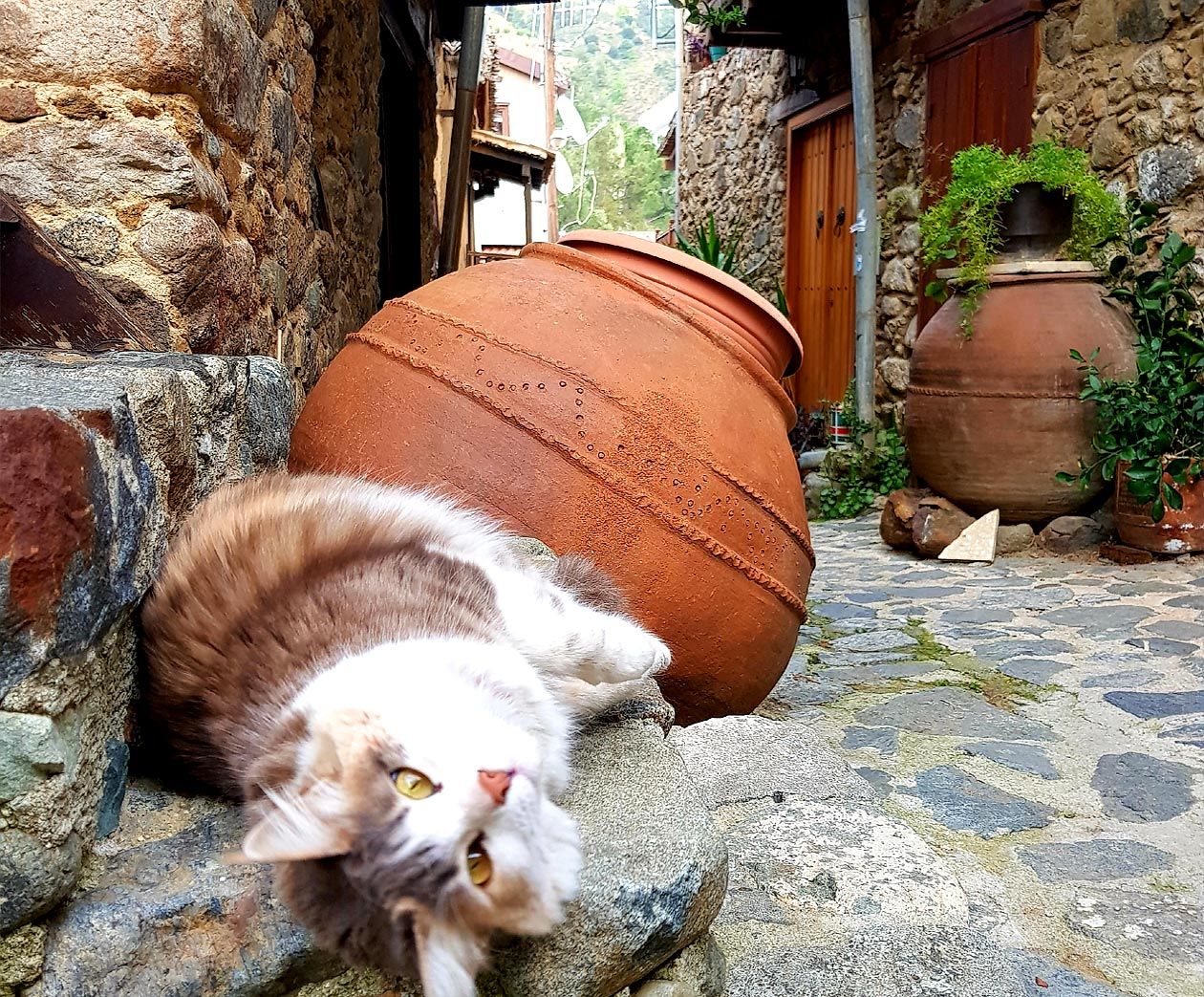
KAKOPETRIA VILLAGE
KAKOPETRIA VILLAGE
Located in the Troodos mountain range, in the Solea Valley of the Lefkosia (Nicosia) region, the village of Kakopetria can be reached from Lefkosia by following the route E901, then the B10, and finally the B9. The pretty village is a popular summer resort, thanks to its charming character and breathtaking scenery of pine forests that stretch across the Karkotis Valley. As such, it is ideal for agrotourism. The old quarter of the village - with its narrow, stone-paved alleys - has been declared a protected heritage site, and its two-storey houses with their wooden balconies have been restored.
The Church of the Saviour’s Configuration (Metamorfosis tou Sotiros), which is built in the centre of the old village is worth visiting, whilst the church of Agios Nikolaos tis Stegis (St. Nicholas of the Roof) is located 5 km from the village. It is considered one of the most interesting Byzantine churches on the island, thanks to its painted murals that date from the 11th to the 17th century.
The village also has several other interesting sights, including the Linos Musuem and Olive Mill museum. The watermill ‘Mylos tis Gonias’ used to grind barley and grain from 1754. It closed down after the Second World War, and was restored in 1980.
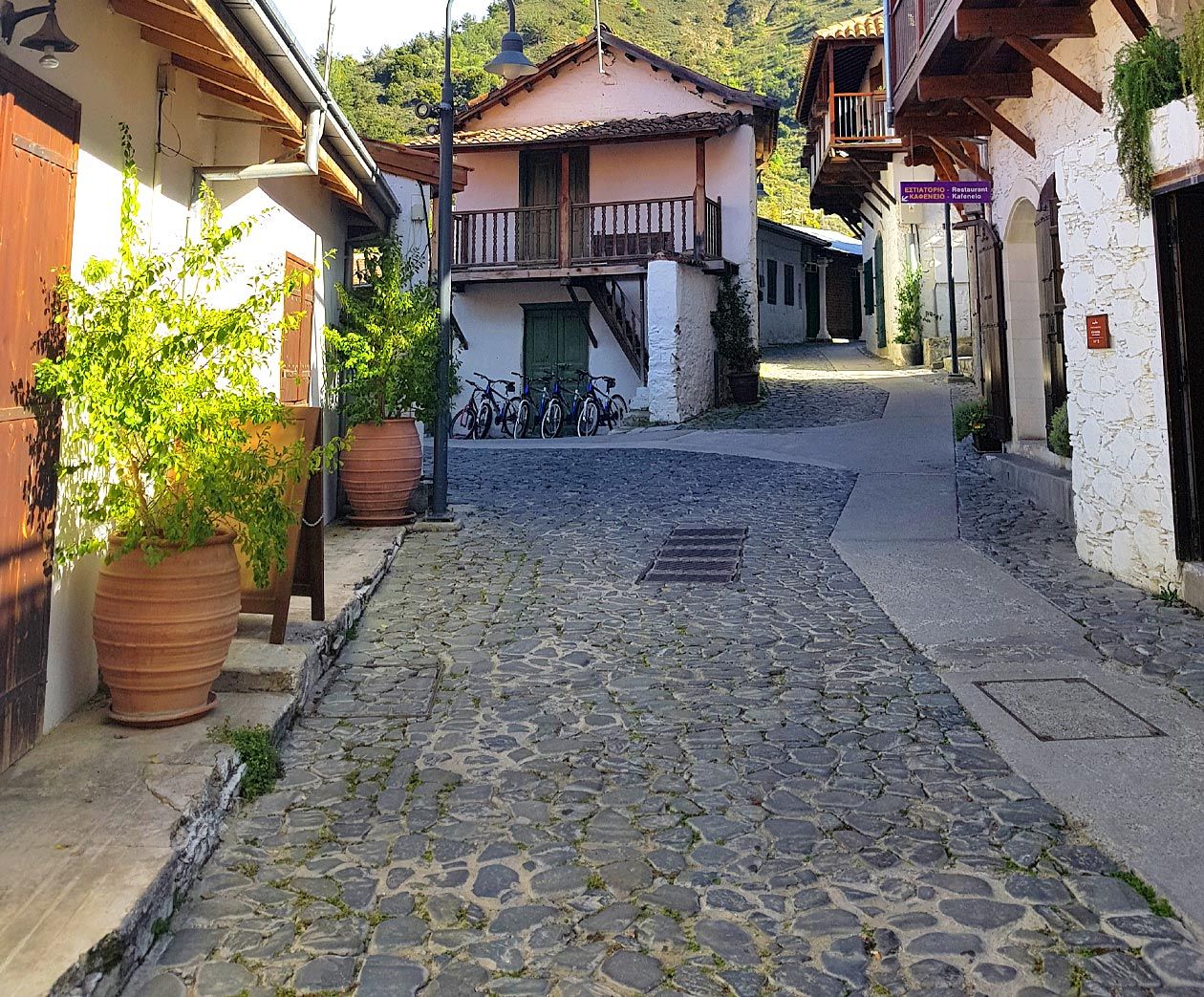
KALOPANAYIOTIS VILLAGE
KALOPANAYIOTIS VILLAGE
Located in the Troodos mountain range, in the Marathasa Valley area of the Lefkosia (Nicosia) district, the village of Kalopanagiotis is 70 km from Lefkosia and can be reached by following the E901 route, followed by the B9, the E908 and finally, the F958.
Kalopanagiotis is one of the most beautiful resorts on the island with its sulphur springs, traditional architecture and panoramic valley views, and is ideal for agrotourism in its peaceful surroundings.
The village’s name means ‘good Panayiotis’ in Greek, after the first inhabitant Panayiotis, who built his house near the Agios Ioannis Lampadistis monastery. The Monastery itself is on the UNESCO World Heritage Site list, and features three Byzantine churches with well-preserved frescos dating back from the 9th to the 15th century.
Interesting sights include the Venetian bridge and the Kykko watermill. The 16th century bridge was constructed from traditional stone, and until recently served as the only access between the village and the monastery. The watermillhas been declared a ‘heritage monument’ by the Cyprus Department of Antiquities, and is an imposing site, characteristic of architecture of the pre-industrial period.
Kalopanagiotis’ charm can also be felt in its other old chapels and churches, the quaint, cobbled streets, and footpaths that lead to beautiful nature trails.
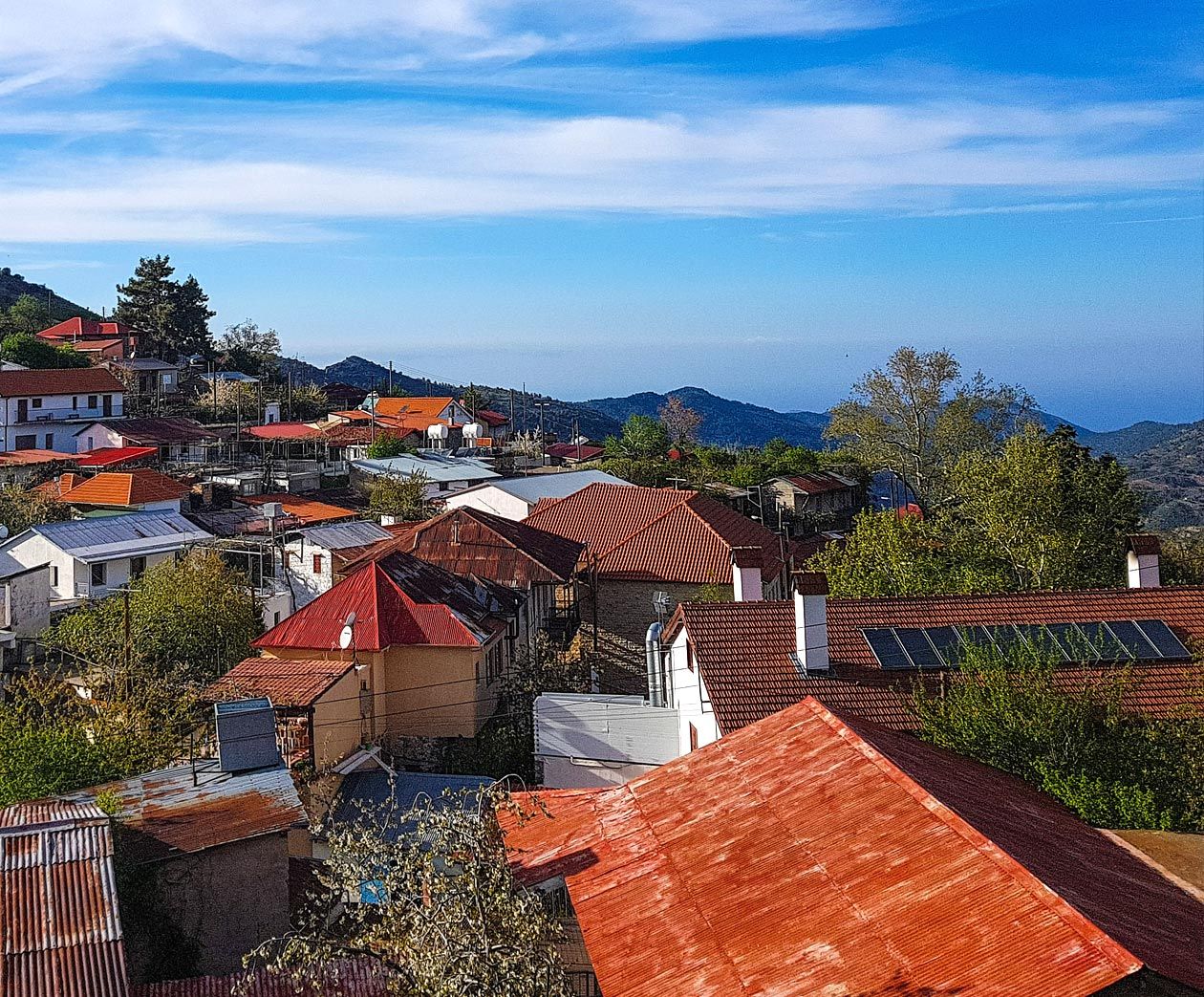
PEDOULAS VILLAGE
PEDOULAS VILLAGE
Located in the Troodos mountains, in the Marathasa Valley of the Lefkosia (Nicosia) district, the village of Pedoulas sits at an altitude of 1.100 metres. It can be reached from Lefkosia by following the E901, then the B9, followed by the E908, and finally the F960. Pedoulas sits amidst orchards and is particularly known for its cherries and the products made from the fruit.
The village is very significant in religious terms thanks to its important church of Archangelos Michael (1474), which ranks among the most impressive Byzantine churches in Cyprus with its amazing frescos. The church is part of the route of 10 Byzantine churches, which are included on the UNESCO World Heritage List. Close to the church is the Pedoulas Byzantine Museum, which was established in order to house and preserve icons and artefacts from churches in the region, with exhibits dating from the 12th century.
Its other interesting sites include the Folk Art Museum, which exhibits the villager’s daily way of life, customs and traditions of the past, and the natural spring, which is said to hold the key to longevity. Many visitors enjoy a refreshing drink of water from the spring when they pass through the village, or stay for a while at one of its quaint hotels.
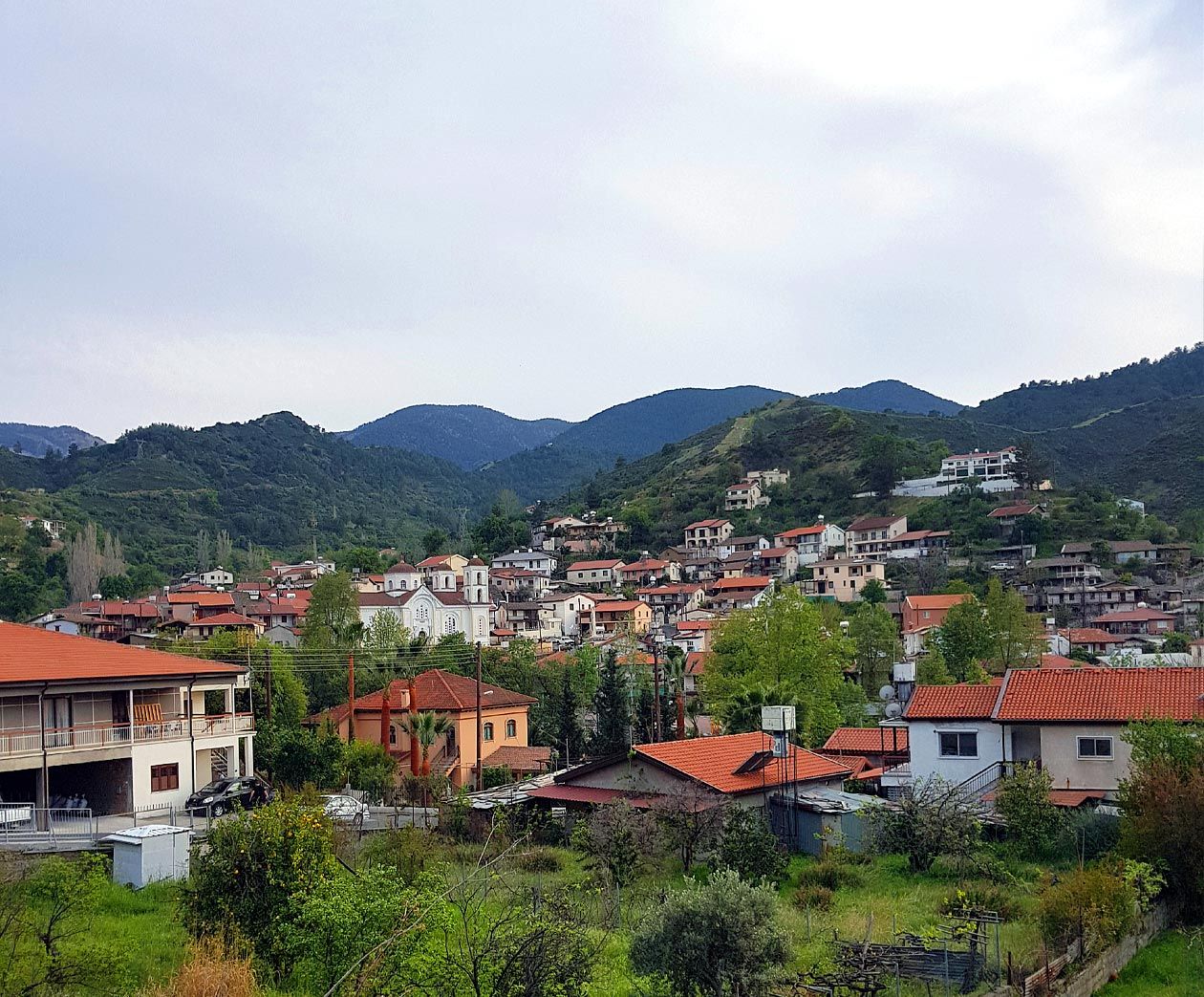
GALATA VILLAGE
GALATA VILLAGE
Galata is located 60 kilometres west of Nicosia in the beautiful valley of Solea. It has an altitude of 620 metres above sea level.
It is built in the two banks of the River Klarios that crosses through it and it is literally drowning in green. It is conjunct with the neighbouring community of Kakopetria. Both these twin hamlets receive thousands of tourists throughout the year.
Galata is famous for its tasty fruits that it produces in large quantities, especially apples of every variety, apricots, peaches, cherries, damsons, grapes, and others, as well as a variety of fresh vegetables.
If one wants to enjoy a few unforgettable summer moments in Galata, he / she must sit at the village's plaza. There, in the shadow of the age-old oak and the plane-trees with the Kargotis (Klarios) River, he / she will have unforgettable moments.
The houses of Galata -both the modern and the traditional ones -possess grace and beauty. One is particularly impressed by the wooden balconies and the wooden stairs of the old, traditional houses.
The tiled, inclined roofs, the local stone with which the houses' walls are made, the latches and bolts, the gateways with their wooden transoms, all these are unfeigned witnesses of contrived folkloric architecture, which is unfortunately dying away as time goes by.
Chiefly however, what is found here is an excellent cultural heritage. The six Byzantine churches with the pyramid-like roofs and their rectangular tiles present to the visitor an unparalleled Byzantine architecture, mainly from the 16 th century››. (Journeys in Cyprus, G and M Karouze).
The History and Tradition regarding Galata -- the village's name
In very old times, there where legend merges with history, in the "Esso-Galata venue west of today's village, some shepherds lived along with their flocks. The people who lived in the lower lands, the "katochorites" (lower-village inhabitants), went there in order to buy milk. The people would say amongst them "lets go over there to the ‹galataes› (plural, milkmen) and buy some milk". Out of "galataes", always according to tradition, came the name Galata.
Another tradition reports that the first settlers came from Galatia of Asia Minor and were named "Galates" (Byzantine era). So their small settlement was named Galata.
In his Chronicle (Annals), Leontios Machaeras reports that Galata belonged to the feud of the "Regas" (king) since 1196.
Galata is again mentioned by Leontios Machaeras in his Chronicle: ‹‹ … Learn…. These Maria said to me…. who took care of Mr. Erricos de Giblet in the village of Galata… ››.
Thus we come to the conclusion that during the Frank Domination era Galata belonged to the De Giblet family.
In Mediaeval maps Galata is found marked under the name Golata and Galata (Iacomo Franco 1570, Galata).
This is what the Russian traveller, Vasiliev Barksy, wrote in 1735 regarding Galata:
He first visited Galata and then the village's monastry of Podithou as he prescripes it.Then he returned back to the village were he spend the night.
‹‹ I went to the nearest village, named Galata, and spent the night close to a Christian along with my companions, which were priests. Let it be known that the villages of Solea have very few Muslim inhabitants, the majority being Greek Orthodox Christians, with many churches and priests. This village is the most beautiful of all. It has many fruit-bearing trees and running water and it is located next to the aforementioned river Klarios ››.
The Village of "Lampadou"
It is not known where exactly the village of "Lampadou" was built. However, the inhabitants of Galata as well as those of the surrounding villages -by tradition -starkly believe that this village or small settlement was located close to the country church of St. George the "Perachorites", east of Kakopetria and to the left of the tourist road to Troodos.
"Lampadou" or "Lampadis" or "Lampadistos" has been the birthplace of two of our Church's Saints, St Herakleidios and St. John the "Lampadistes" (the Illuminator).
The following reasons reinforce and confirm the view that Lampadou was located in the aforementioned area.
• According to St. John the Illuminator's "Akolouthia" (service) of 1667, he came from ‹‹ the hamlet of Lampadou of the Galaton district ››.
• In an unpublished manuscript (Φ13 β) it was mentioned that: ‹‹ He was a Cypriot -St. John the Illuminator -from the region of the Solea district, from the village Lampadou ››.
• The Russian traveller Barsky who in 1735 spent one night in Galata, during his tour ‹‹ in all the monasteries of Cyprus ›› mentions: ‹‹ John -a saintly man -the Illuminator from the village of Lampadis, where the Saint was born and which now has been abandoned as I have ascertained when I was in Solea ››.
• One of the "Aposticha" (types of verses) that refers to St. Herakleidios goes like this: « Τόπους αμειβόμενος οι του Σωτήρος Απόστολοι προς Σολέαν ιθύνονται και δόξαν κηρύττοντες Ιησού του Λόγου , άχρι της Λαμπάδου , ένθα και εύρον τον φαιδρόν θείον και πάνσοφον Ηρακλείδιον , δοχείον καθαρώτατον και μύστην υπάρχοντα Ελληνικής διαθέσεως , όν διδάξαντες έλεγον , σέβειν ένα Θεόν ημών », narrating how the Apostles, preaching the Word of God, came to Lampadou and taught St. Herakleidios about Christianity.
• In the service of St. John the Illuminator of 1774, h is mentioned as descending ‹‹ from the village Lampadistou of Solea››.
• Sofronios, the former Metropolitan Bishop of Leontopolis writes in his 1935 opus "Hagiology of the Orthodox Church": ‹‹ Saint John the Illuminator, from Cyprus (October 4 th ). In no hagiographer have I encountered a memoir of him… He is celebrated in Cyprus, descending from Lampadou (a village by the hamlet of Galata) and thus having this name ››.
• At a small distance outside Galata there is a bridge called "giofyrin t' Aerakleidkiou", that is bridge of St. Herakleidios.
• There is a venue quite near Galata named "Moutte tis Lampadou" (nose or peak of Lampadou).
• In the Byzantine churches of Galata and Kakopetria there are frescoes depicting St. Herakleidios and St. John the Illuminator.
• ‹‹ Again the mention of a settlement under the name Lampas in the "district of the Galates" indicates that the settlement must have been in the Solea region (where the large village of Galata is) ››. (History of the island of Cyprus, volume II, Andros Pavlides).
St. Herakleidios
From the Hagiography of St. Herakleidios -and also from other sources -we can conclude that he was an idolater (heathen) and a son of a certain Hierokleous or Hierokles, a heathen priest. It is known that the ancient people in Cyprus, like the ancient Greeks, believed in the twelve Gods of Olympus.
When the Apostles Paul and Varnavas came to Cyprus in 45 AD to preach the Nazarene's religion, they passed by Lampadou that was close to Galata. Here the Apostles met the then young Herakleidios along with his father who -at that moment -was offering a sacrifice to the Gods. Hierokles invited them to take part in the sacrifice. The Apostles refused. They only asked to be shown the wrote to Pafos.
Hierokles allowed his son, Herakleidios, to escort the Apostles and show them the way.
As they were walking, the Apostles taught to Herakleidios the true religion of Jesus Christ and its superiority, in comparison with the religion he believed in. Herakleidios was thrilled with the new religion, became a believer, and was baptised. The Apostles ordained him as the bishop of Tamassos.
St. John the "Lampadistes" (Illuminator / torch bearer)
St. John the Illuminator descended from Lampadou, as his surname reveals, just like St. Herakleidios. ‹‹ … from the renowned island of Cyprus, from the village of Lampadou in the district of Galata››. (Costas Myriantheas St John the Illuminator)
He lived during the 11 th century. His parents were the priest Kyriakos and his mother Anna.
He was nurtured with the essence of the faith and learned the holy scriptures from an early age. Because of his great love for God, he dedicated himself wholeheartedly to Him.
When he was 18 years old his parents were pressing him to be engaged, forgetting that their son was the fruit of their prayers and pleas.
After the engagement, John decided to break his engagement and dedicate himself to God. He announced to the parents of his fiancee his irreversible decision. In spite their bitterness and their feelings of being insulted, they pretended that they still had loving feelings for him. They invited him to dinner and poisoned him and as a result John was blinded. The scene of this lethal dinner with the poisonous fishes that they offered to him is depicted in a large portable icon, which is found in his monastery in Kalopanagiotis.
He was now blind. But he says "If they have taken from me the eyes of the body, the eyes of the soul exist, so that I will praise the name of God with greater zeal".
With the help of a servant who had the same name as he did, he leaves Lampadou and ascends to the monastery of his fellow-villager, St. Herakleidios.
He lived three years of angelic, ascetic life "teaching everyone that -if they want- they are able to live 'close' to Christ".
He was 22 years old when he delivered his "snow-white soul" to the Lord.
Agrotourism in Limassol
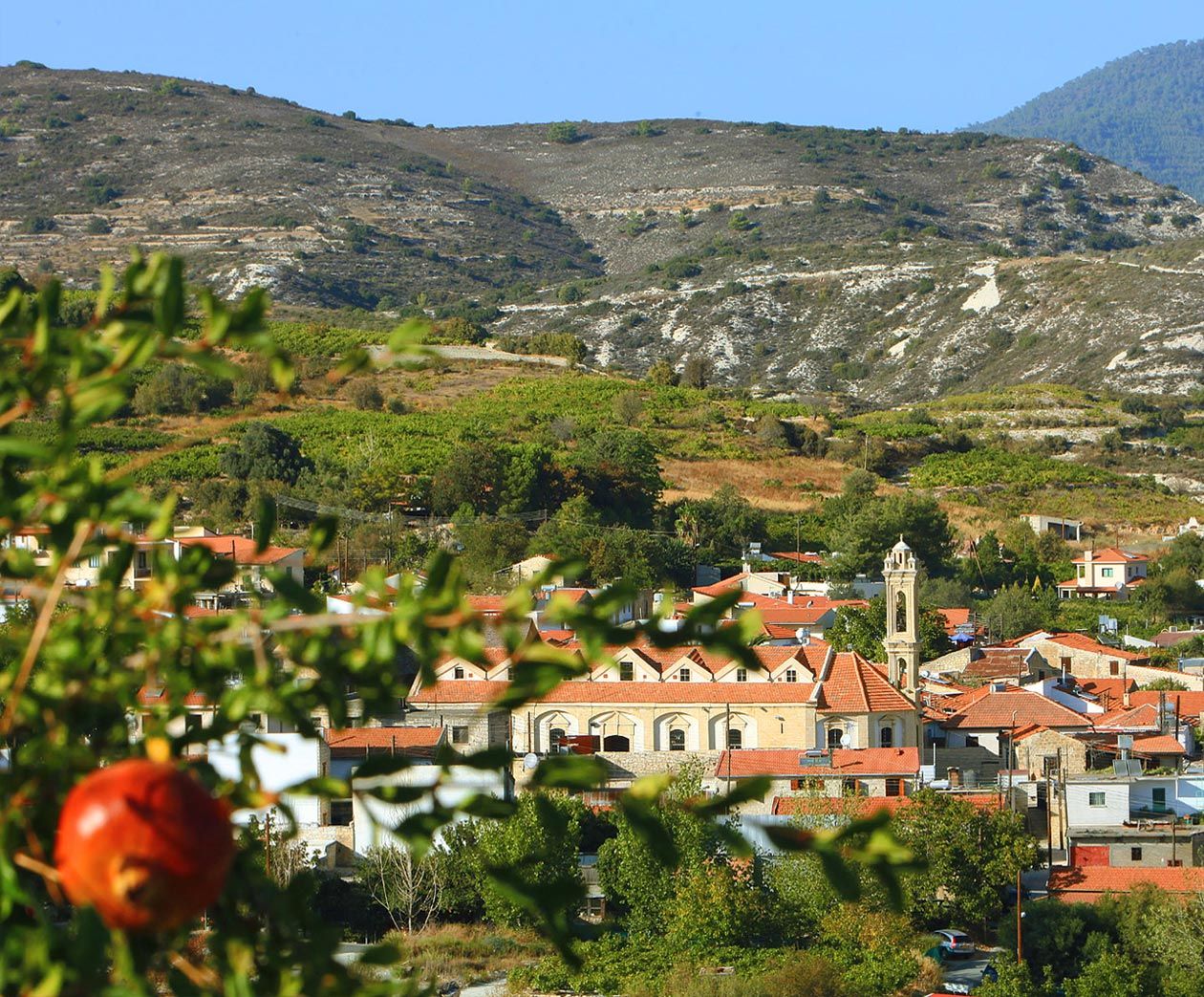
OMODOS VILLAGE
OMODOS VILLAGE
Located in the Lemesos (Limassol) district, the pretty, wine producing village of Omodos sits at an altitude of 800 metres on the Troodos mountain range, in the beautiful area of ‘Krassohoria’, just 42 km from Lemesos town. The village can be reached by following the E601 route, or by following the B8 route, then the E802 route and thereafter, the F825 route. Omodos is one of the most traditional and charming villages on the island.
The village has existed since the Frankish period and is marked as ‘Homodos’, and ‘Homoclos’ on old maps, with its name originating from the Greek word for street - ‘odos’.
Famous for its wine, Zivania spirit, handmade narrow-knit lacing and ‘arkatena’ bread, its quaint environs are perfect for agrotourism.
Despite its small size, Omodos has many interesting sights. Located within close proximity of one another are the cobbled square, old stone-built houses, local wineries, a Medieval wine press and the monastery of Timios Stavros (Holy Cross), with its old icons and impressive woodcarvings. There is also a museum dedicated to the National Liberation Struggle, as well as a centre for the preservation of narrow-knit lacing, and an Icon Museum.
Every September 14, the village holds one of the biggest religious fairs on the island, dedicated to the Holy Cross. The celebration lasts for three days, and vendors gather in the beautiful square in front of the monastery to sell their wares. The square is also the scene of many other events during the summer and Easter.
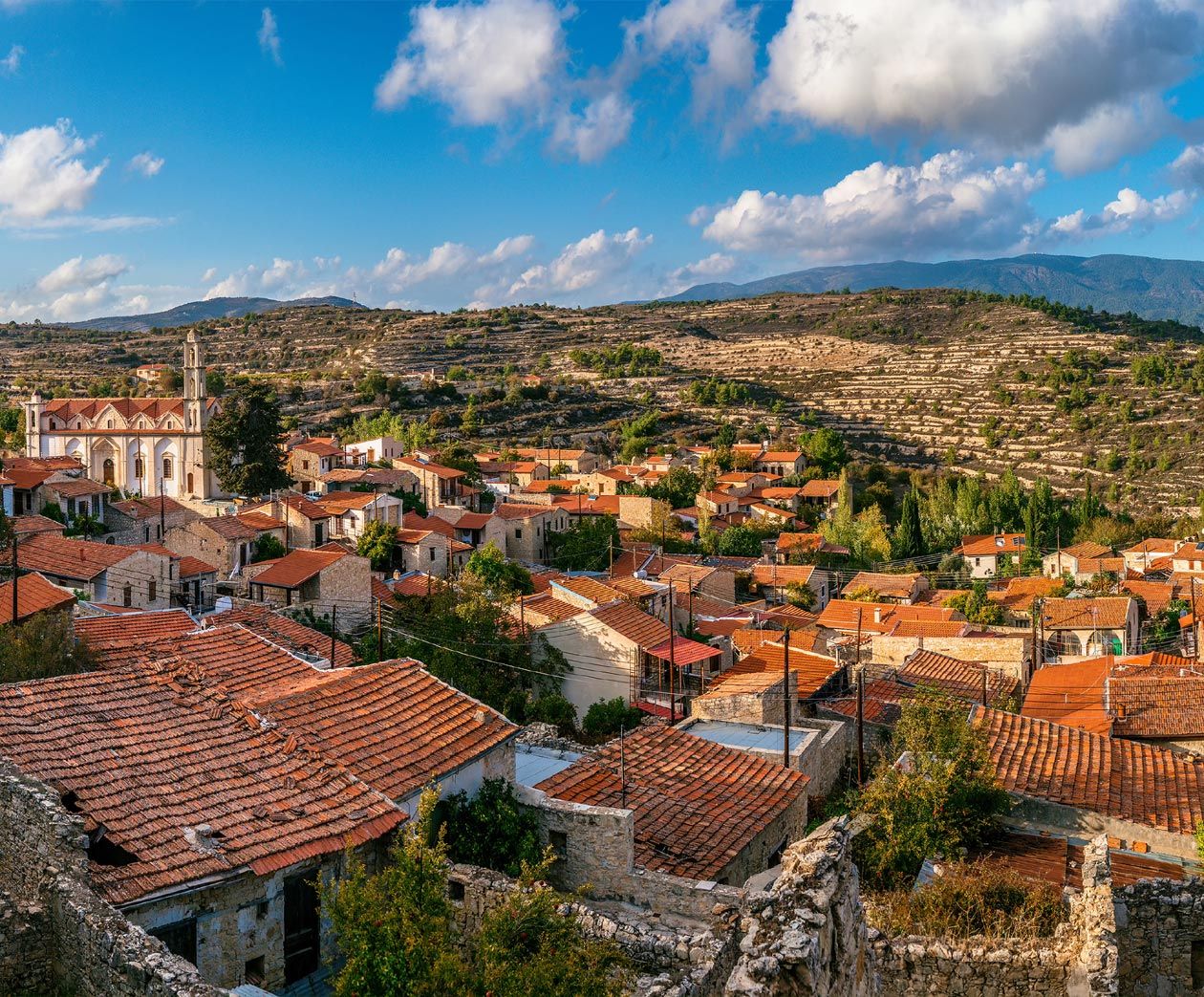
LOFOU VILLAGE
LOFOU VILLAGE
Located in the Lemesos (Limassol) district, the tiny village of Lofou sits at an altitude of 780 metres, just 26 km from Lemesos town. Lofou can be reached by following the B8 route and then the F617 route, or by following the E601 route, and then the F617 route.
The village takes its name from its position on top of a hill (‘lofos’), and has retained its name since Byzantine times. It is renowned for its pretty, old architecture, and the many winding, cobbled streets.
The leafy environs of this picturesque and traditional village are home to grapevines and almond trees, offering agrotourism in tranquil and scenic surroundings.
Among its interesting sights are a small agricultural museum, the old school of Lofou, and the traditional faucet of Elitji, dating back to 1842. The faucet is where the villagers of Lofou used to collect water in the olden days, and was an important part of their daily life.
The village also has two religiously significant monuments; the 19th century village church dedicated to the Annunciation of Virgin Mary, and the nearby small chapel dedicated to Prophet Elias, whose icon is believed to have miraculous powers to stop the rains from causing damage to the grain crops.
At the end of September, the village celebrates its harvest with a Grape Fest, where visitors can watch the locals make traditional delicacies from grape juice, and sample them with their compliments. There is also a programme of folkloric entertainment, as well as wine tasting.
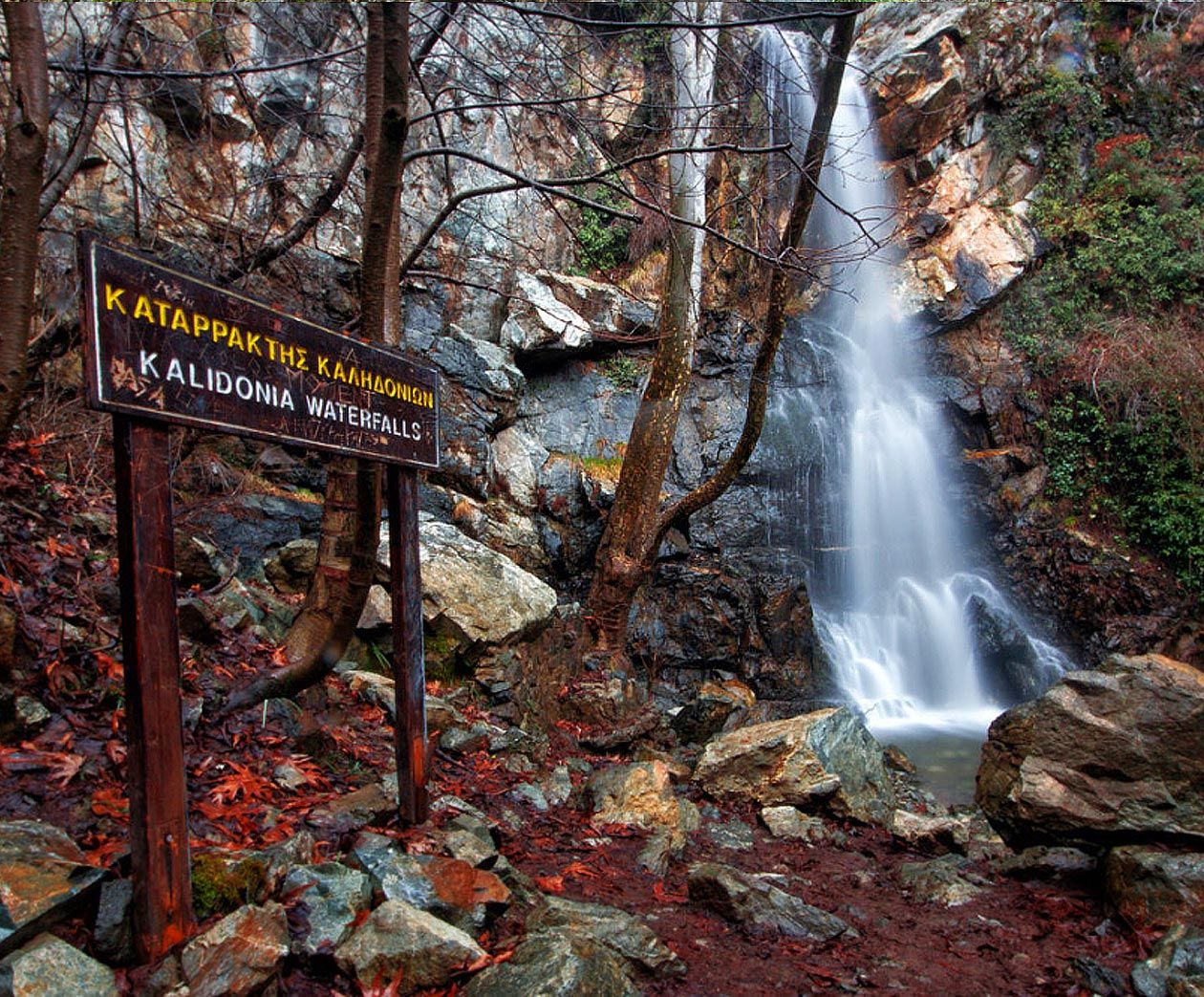
PLATRES VILLAGE
PLATRES VILLAGE
Located in the Troodos mountain range, in the Lemesos (Limassol) district, the village of Platres sits at an altitude of 1.100 metres. It can be reached from Lemesos by following the B8 route, and then the F825 for Kato Platres.
The picturesque village resembles an amphitheatre, with the lower part of the village having one altitude and the upper part having another, thus separating it into Pano (upper) and Kato (lower) Platres. It is a popular holiday destination and offers accommodation in quaint hotels.
There are various versions of where the village takes its name; from a ‘platria’ (saleswoman) who lived there; from the French word ‘platre-s’ - (‘white plaster’); from monks in white known as ‘Platrai’ during Frankish times, or from the word ‘platsa’.
Aside from the nature trails, Platres has one of the highest waterfalls in Cyprus - Caledonia - believed to be named by English or Scottish visitors to the area in 1878. The village is also filled with charming old buildings, and has a winery in Kato Platres.
Visitors will also enjoy its unique attractions, which include a chocolate workshop, an adventure rope park, and an exhibition at its Cultural Centre which incorporates old photos of the village, and of the Greek poet Giorgos Seferis.
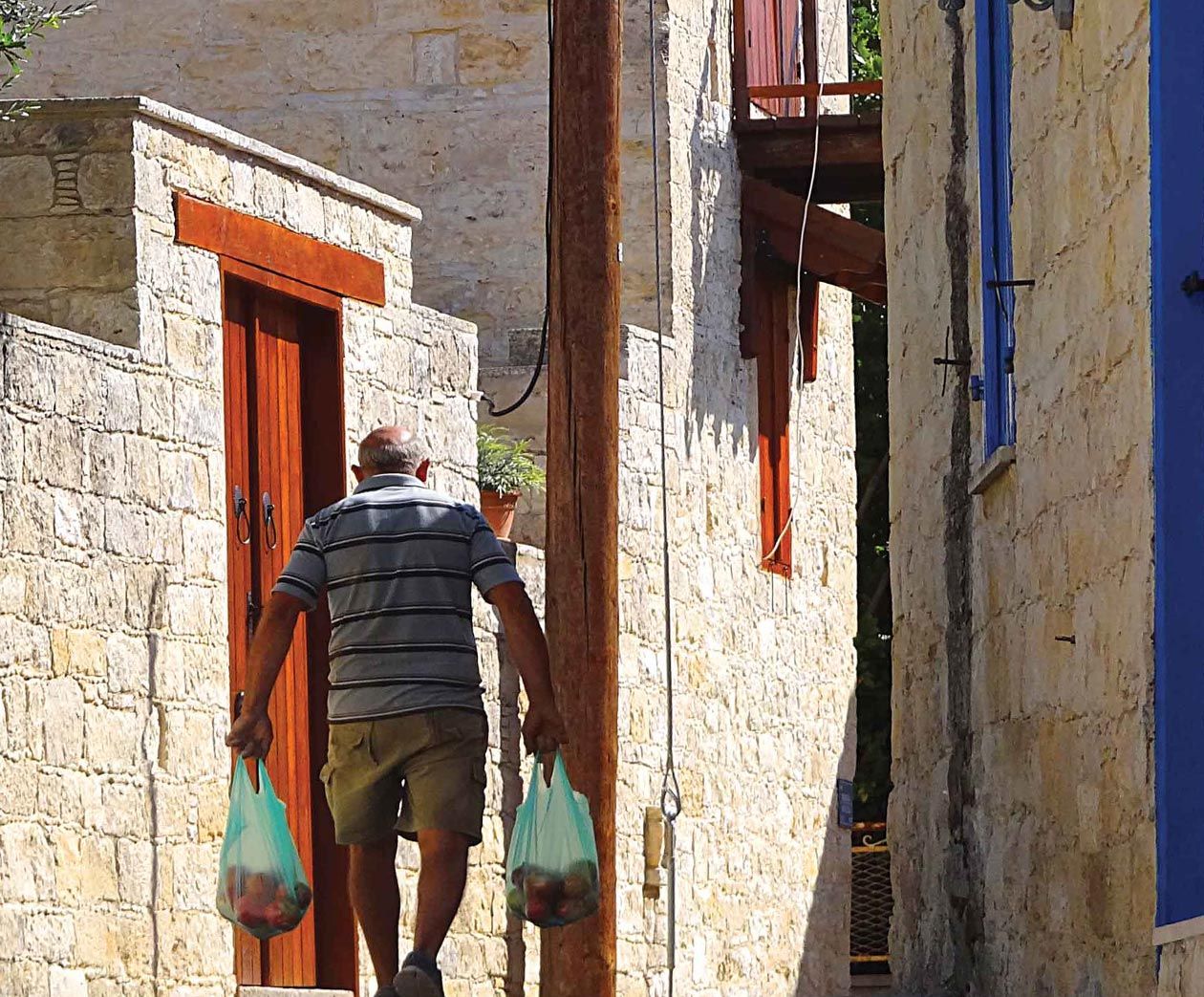
ARSOS VILLAGE
ARSOS VILLAGE
Located in the Lemesos (Limassol) district, the picturesque village of Arsos is built on the slopes of Laona mountain at an altitude of 850 metres, and just 42 km from Lemesos town. The village can be reached by following the A6 route and then the E601 route.
Arsos has practised the tradition of winemaking since ancient times, having developed into a large wine-producing village with a rich viticultural history.
Its name is believed to either come from the Holy Alsos (grove) of the Goddess Aphrodite, where the village is built, or its status as one of the four towns founded by Ptolemy Philadelphos in honour of Arsinoe.
Interesting sights include the Folk Art Museum, the ‘Six Fountains’ nature trail (that joins six medieval fountains along the river), its churches and a winery. Arsos is also an idyllic destination for agrotourism.
The village holds a Grape Feast annually at the end of September to celebrate its harvest, where visitors can watch how the locals make traditional delicacies from grape juice, and sample them with their compliments. There is also a programme of folkloric entertainment, as well as wine tasting. A second major event is held annually on November 14, with a religious fair in honour of Apostle Phillipos - protector of the village, with traditional stalls.
Agrotourism in Larnaca
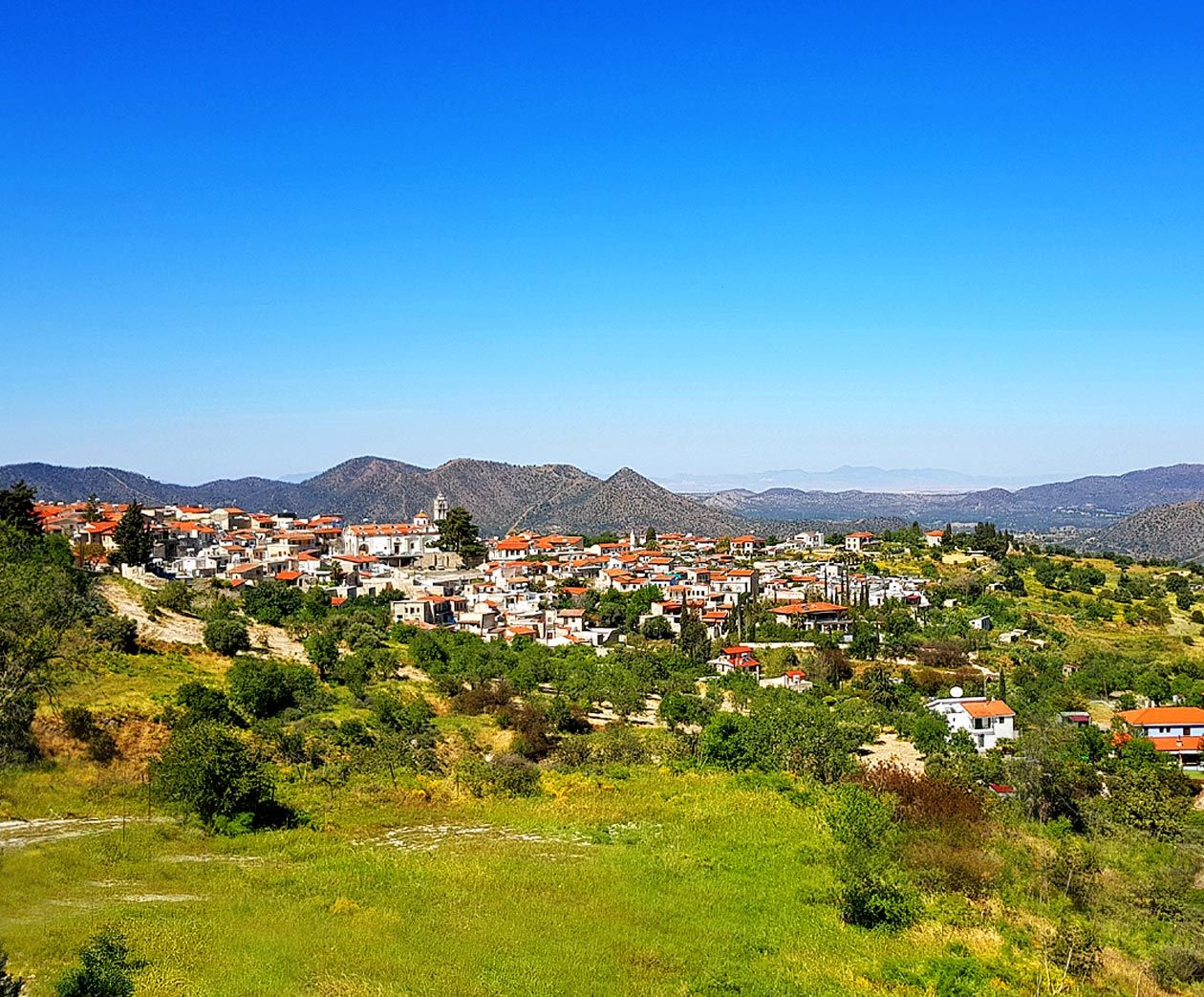
PANO LEFKARA VILLAGE
PANO LEFKARA VILLAGE
Located in the Larnaka (Larnaca) region, the mountainous village of Lefkara is split into Pano Lefkara and Kato Lefkara (higher and lower Lefkara), and is world-renowned for its traditional handicrafts of lace embroidery and filigree silver. The village is situated at the foot of the Troodos Mountains in the south eastern region, 650 metres above sea level, 43 km from Larnaka, and can be reached by following the A5, A1 and E105 routes.
The crafts of lace and silver have been practiced in the village since Venetian times, and visitors can learn all about them, and watch the lace and silver being made at the Lefkara Handicraft Centre, the Museum of Traditional Embroidery and Silversmithing, and various workshops. Legend has it that the famous painter, Leonardo da Vinci himself visited the village in 1481 and bought a lace altar cloth, which he donated to Milan cathedral.
The character of the village is very picturesque with its narrow, winding streets and traditional architecture of old, terracotta-roofed houses. It is also included as one of the stops on the island’s 7th Wine Route that encompasses the area of mountainous Larnaka - Lefkosia (Lefkosia).
Among its interesting sites are the Folklore Museum, the old fountain and the old olive mill. The village also has beautiful and ancient chapels, including the church of Timios Stavros (Holy Cross), and the chapel of Archangelos Michail in Kato Lefkara, with frescoes that date from the 12th and 15th centuries.
The popular annual Lefkara Festival takes place each August, and includes a programme of music, dance, theatre and handicraft exhibitions, with visitors warmly welcomed.
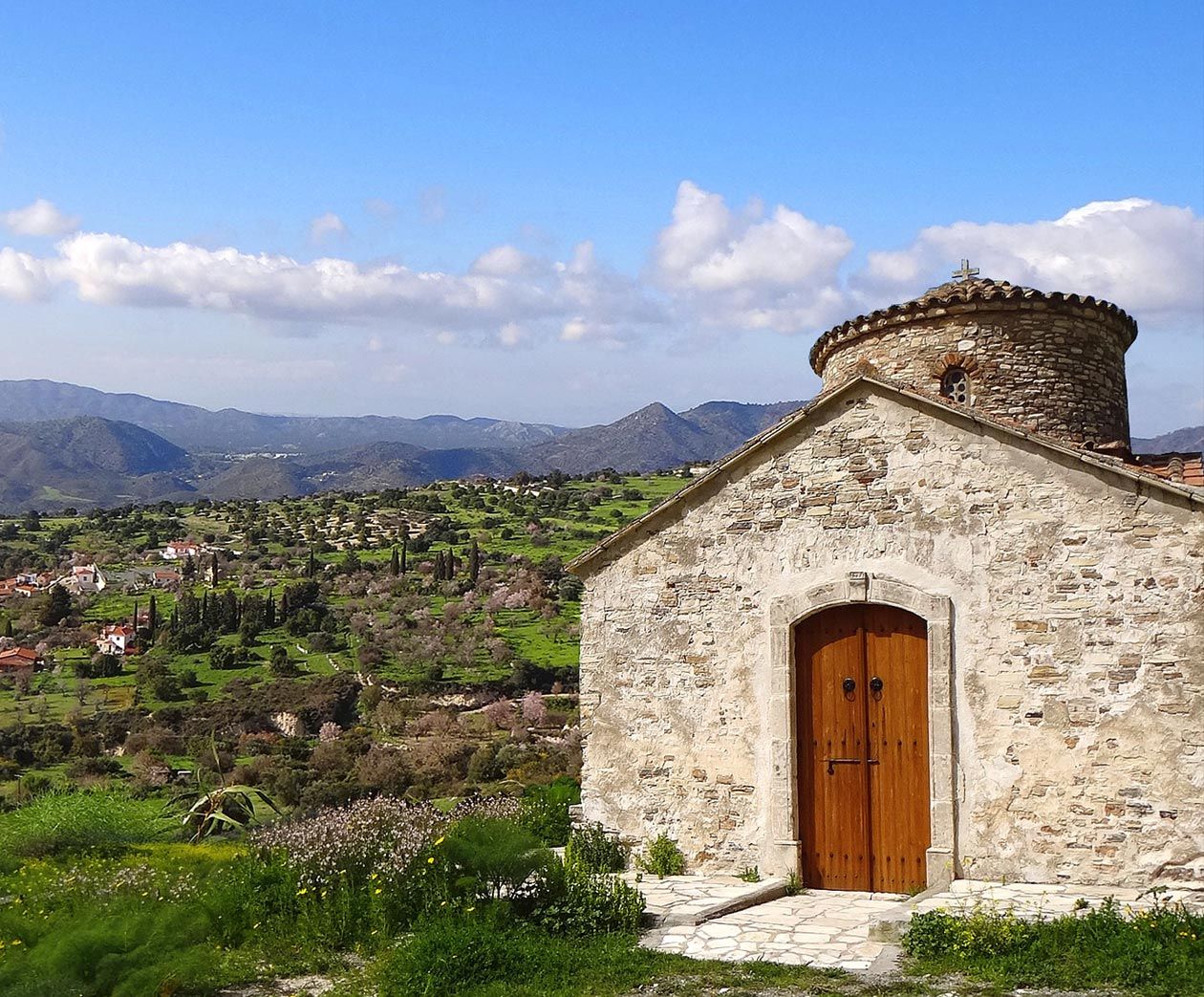
KATO LEFKARA VILLAGE
KATO LEFKARA VILLAGE
Kato (Lower) Lefkara is a village of the Larnaca district and it is located about 34 kilometres south-west of the city of Larnaca.
The community is built on an average altitude of 480 metres. The terrain is hilly and the altitude in the north-east of the settlement reaches up to 417 metres ("Shinokefalos" hilltop). The landscape is fragmented by the rivers Syrkatis and Argaki, and of St. Minas, all tributaries of the Pentaschoinos river.
Kato Lefkara receives an annual rainfall of about 570 millimetres. In the village's limited cultivable land, vines (of wine-making varieties), olive, almond, and carob trees, a few citrus-trees, forage plants, broad beans, a few fruit-trees (fig, pomegranate, and plum trees), and very few vegetables are cultivated. However, the village's greatest part is uncultivated and wild, natural vegetation grows in it, mainly pine-trees, thorny burnets and brooms, sages (cistus), thyme, and wild carob and olive trees.
As far as transportation is concerned, Kato Lefkara is connected to the neighbouring village of Pano (Upper) Lefkara in the north-west (about 1 km), with the village Kato Drys in the south-west (about 4 km.), and with the Skarinou Station in the south-east via the Nicosia - Limassol Highway (about 8 km).
The art of needlework (embroidery) developed in Kato Lefkara can also be found in neighbouring village, Pano Lefkara, and have reached a very high level of mastery. Ebroideries here are available in a very large variety and are manufactured locally. What characterizes them is the affluence and the diversity of design.
The separation into Upper (Pano) and Lower (Kato) Lefkara was observed since the times of the Turkish domination, thus the latter village must have been established by banished Greeks. In earlier sources Lefkara is mentioned as a single settlement, obviously being Pano Lefkara.
The village was a strong and rich feud during the years of Frank domination and de Mas Latri includes it in the list of royal estates. Besides, in older maps the village is marked as Lefkara and / or Lescara.
However, Lefkara is one of Cyprus's villages that we know for sure it existed before the Frank domination era -during the Byzantine times -for which there are no sources that are adequately detailed. The village was claiming the honour of being considered as the birthplace of the significant Cypriot Saint Neofytos, who is however reported as being born in the neighbouring village of Kato Drys. It seems that local tradition attempted to compromise this dispute, regarding the Saint's decent, by relating that his parents came from "Apliki" -a settlement that existed between Lefkara and Kato Drys -moving however to Kato Drys (where the Saint was born in the 12th century) and later also residing in Lefkara.
The mediaeval annalist Leontios Machairas accepts the descent of Saint Neofytos from Lefkara. In any event, in one of his own writings, Saint Neofytos himself mentions Lefkara as the place of his origin.
There are three different interpretations regarding the name "Lefkara": the first supports that it comes from the words "Lefka Ori" (White Mountains), because the region has the white coloured, rough, limestone and fire-stone landscape as its main characteristic. The same natural, white colour of the region's rocks also characterises the appearance of all the stone-made houses, the paved alleys, and the dry-stone, protective structures in the fields, which were made with the local stone of the "White Mountains". The second interpretation supports that the villages received this name due to the tufts of small, white poplars that grew in their region. Finally, there is the opinion that perhaps the name came from some settler who was named Lefkalos.
Pano and Kato Lefkara, two entirely separate and independent villages, though with a common and interrelated existence, occupy a privileged position on the west, mountainous region of the Larnaca district. Built -side by side -on the edges and the foot of the Sotira mountain, the two villages are adjacent to the Neolithic settlement of Choirokitia and the monastery of Saint Minas.
The first written testimony for the existence of Lefkara under today's name is given by Saint Neofytos in his book "Typiki Diathiki", in which he mentions that he was born in Lefkara in 1134. The Saint's descent from Lefkara is confirmed by his relevant chant, which characterises him as the Glory of Lefkara. This watertight, chronological testimony reveals the existence of Lefkara -as a community -in 1134, which is placed in the end of the Byzantine era (395-1191). Undoubtedly, Lefkara continued their historic tradition and their cultural progress -as the same communal entity -throughout the duration of the Byzantine era.
The second historical testimony goes back to the times of the Frank domination (1191-1570) and reports that all the leading members of the military Order of the Templars were exiled in Lefkara in 1308 and for three years; their inadmissible behaviour obstructed the smooth operation of the Frank regime in Cyprus. In any event, it is reported that -during the 15th century -Sor de Naves, Constable of Cyprus, served as Lord of Lefkara.
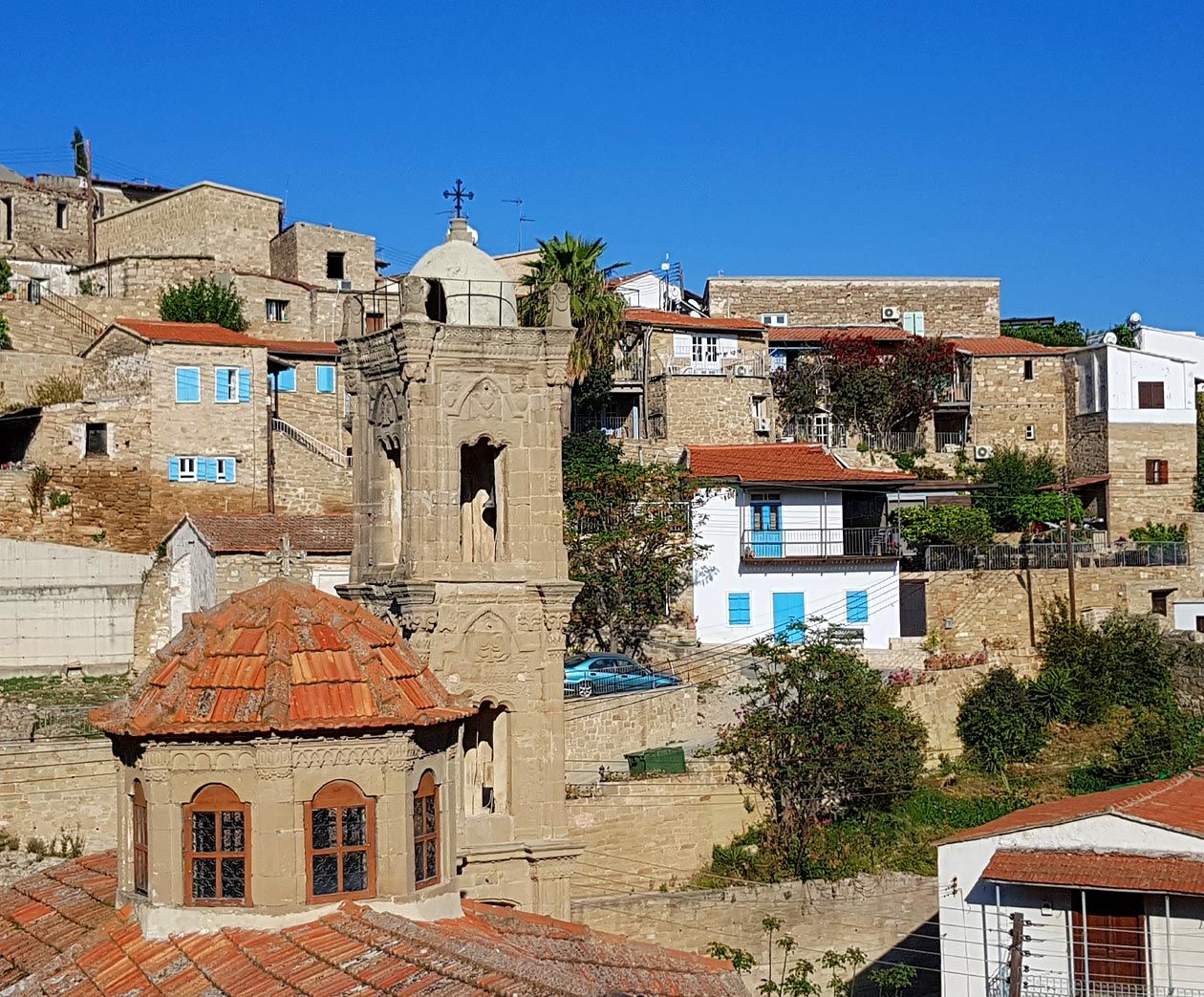
TOCHNI VILLAGE
TOCHNI VILLAGE
Located in the Larnaka (Larnaca) region, the pretty village of Tochni is the perfect, idyllic destination for agrotourism, and one of the oldest villages on the island. Standing approximately. 36 km southwest of Larnaka, the village can be reached by following the A5, A1 and F116 routes.
Interesting sights include the charming village houses - built from ‘Tochni stone’ that is quarried nearby - a small Byzantine Museum, and a Latin church in the centre of the village. The church overlooks the Orthodox church of Agios Constantinos and Agia Eleni (St Helena), and has been reconstructed on the site of the original, said to have been founded by St Helena on her return from the Holy Land, having brought with her a piece of the Holy Cross.
The pretty landscape of the village and its surrounding area also make it great for exploring by bike, with various bike centres in the village, as well as horse-riding.
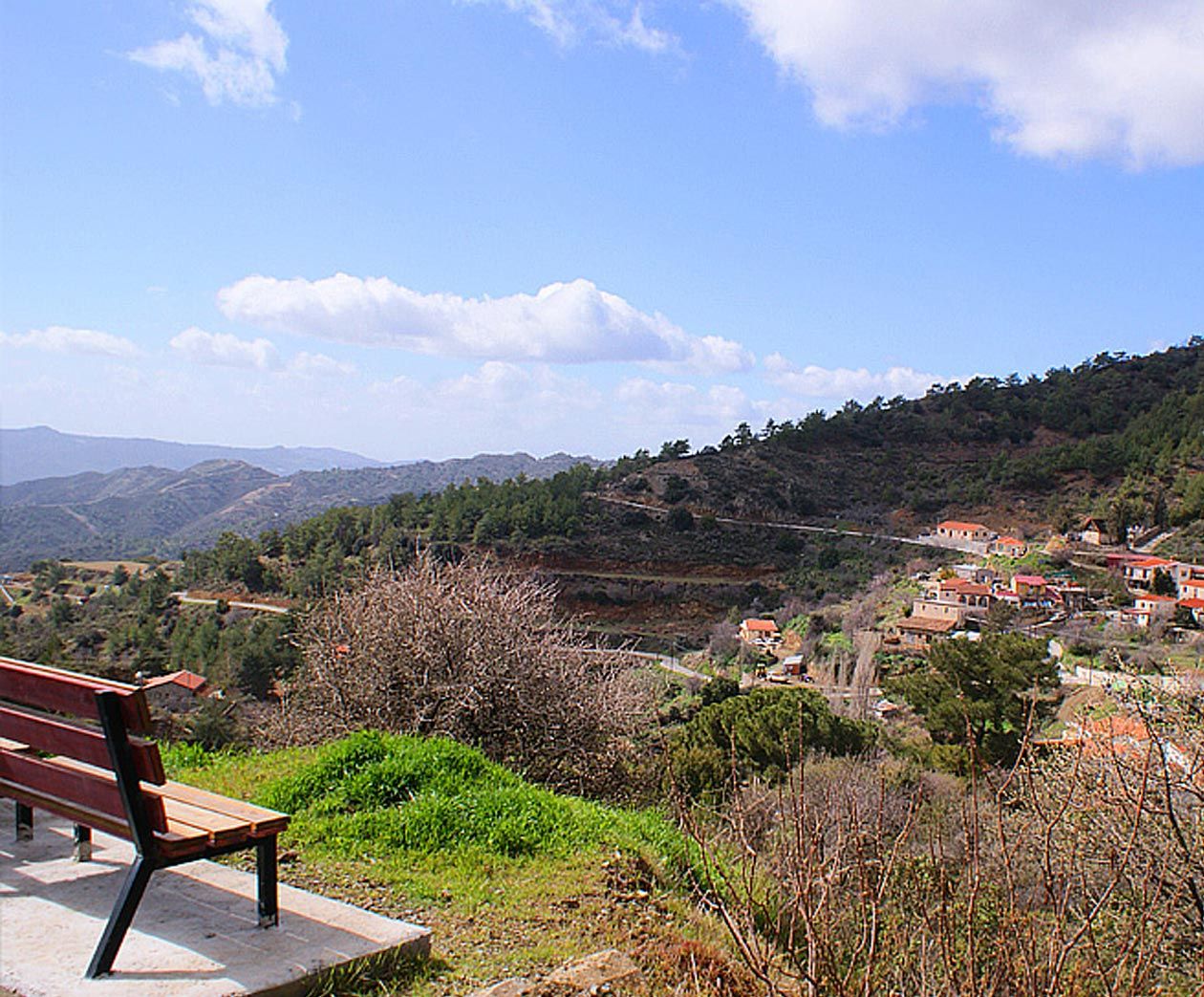
VAVATSINIA VILLAGE
VAVATSINIA VILLAGE
The village of Vavatsinia was founded during the Arabic raids.
The first inhabitants were shepherds coming from the nearby villages Panayia, Ayios Nicolaos and Ayia Marina.
The residents of these villages had to leave the shore to escape from the Arabs and to find rescue on the mountains, together with their animals.
The village has taken its name from one black currant tree, which still exists by the river and its producing big black currants.
The specific tree’s root was a natural water source and was a meeting place of travelers coming from the nearby villages of Ayioi Vavatsinias, Odou, Ora towards the village Lefkara.
Members of the village who have participated in the struggles of the Greek nation in the last two centuries :
- Kyriakos Christou. According to the book by Loizos Philippou, ‘cypriot Fighters’ published by the Archdiocese of Cyprus, Kyriakos Christou from Vavatsinia took part in the Greek struggle for independese of 1821.
- Nicos Patsalos. Nicos took part in the struggle for independence of 1955-1959. He was a very popular member of the village.
- Alexandros Papachristophorou. During the Turkish invasion Alexandros fought at Mia Milia and is one of the many missing persons. Both his parents were from Vavatsinia.
Agrotourism in Paphos
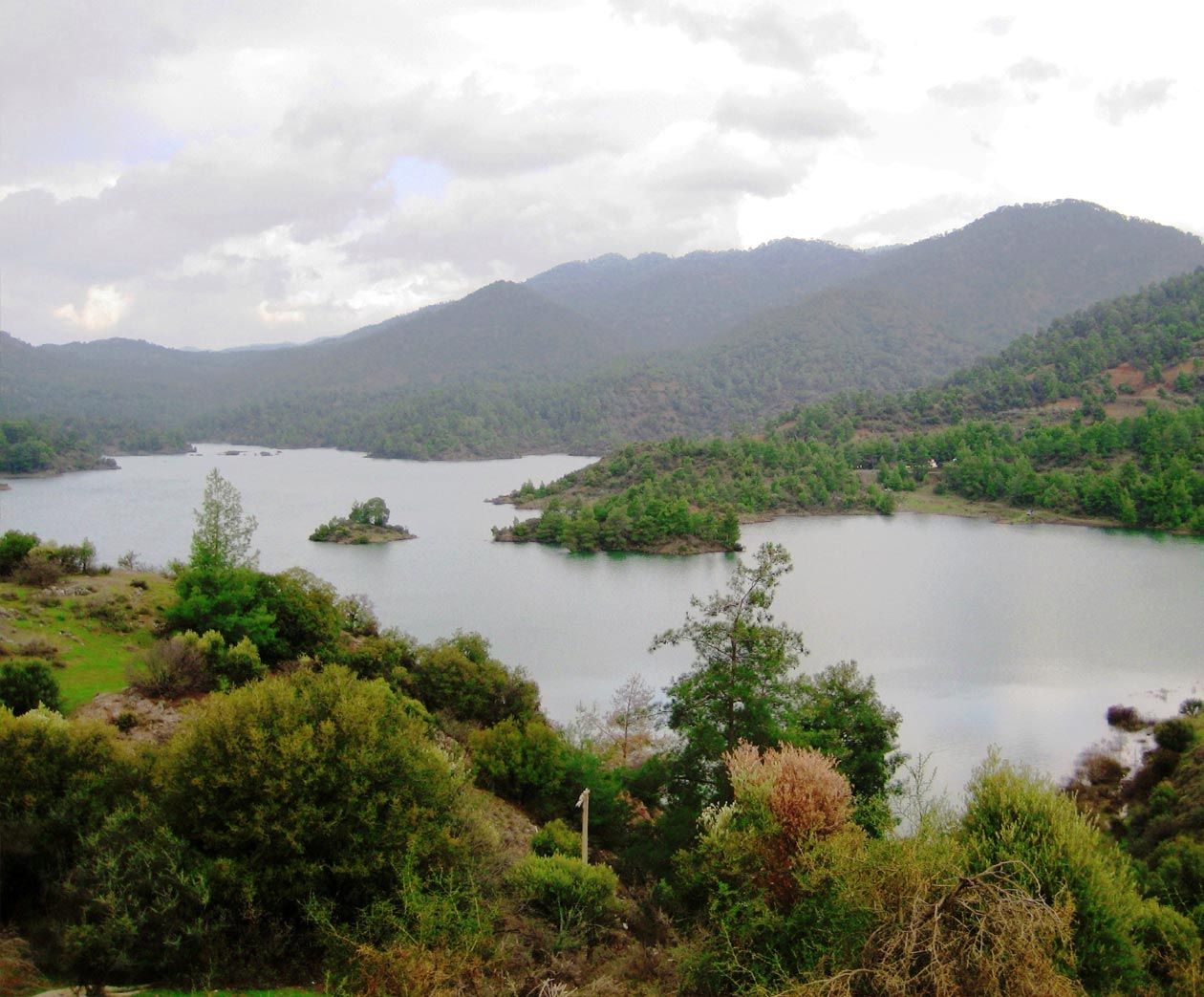
PANAGIA VILLAGE
PANAGIA VILLAGE
Located in the Pafos (Paphos) region, some 33 km northeast of Pafos town, the beautiful village of Panagia offers agrotourism in its natural environs, with its largest part located within Pafos Forest, at an altitude of 850 metres above sea level. It can be reached by following the A6 from the town of Pafos, and then the E606.
The village’s name comes from Panagia (the Virgin Mary), to whom the neighbouring monastery of Panagia Chrysorrogiatissa is also dedicated. One theory believes that under Frankish rule, Panagia village was a fief called ‘Casal Nostra Donna’ (of the Virgin Mary). The monastery houses an interesting Icons and Utensil Treasury, whilst a large religious festival is held annually on August 14 in honour of the Virgin Mary.
The village is also famous for being the birthplace of the Republic’s first president - Archbishop Makarios III - with two museums dedicated to the late Archbishop; the family home of the Archbishop, and the Museum of Cultural Foundation Archbishop Makarios III.
Other interesting sights include the various local wineries, the monastery of Agia Moni and the Vouni Panagias Nature Trail, which begins at the town square, and takes three hours to complete. Visitors can also enjoy the festival ‘Ta Rogiatika’, which takes place annually on August 15, and includes a programme of music and dance.
The main crops of the village include grapevines, various fruit trees, pulses, almond and olive trees, amongst others.
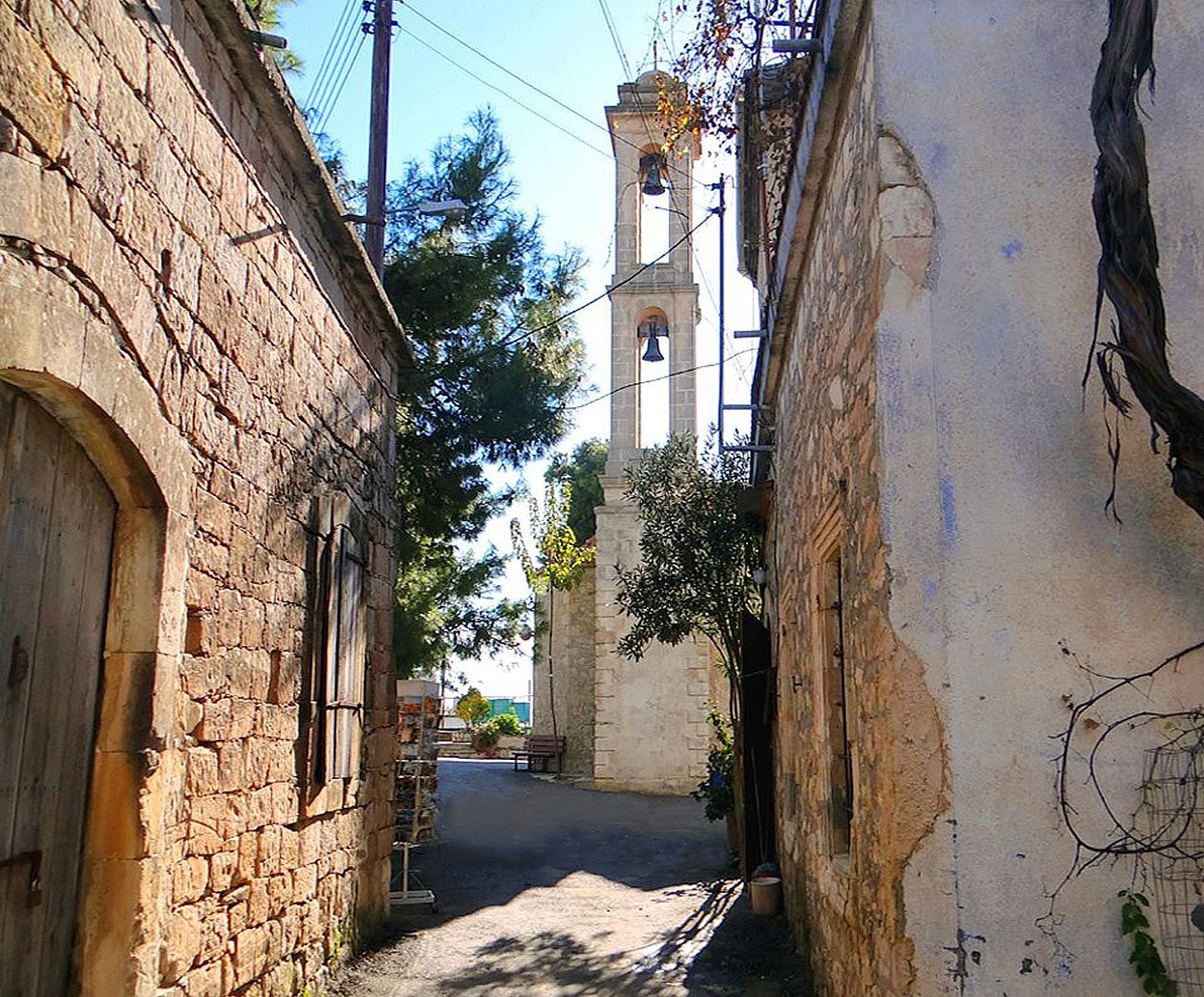
FITI VILLAGE
FITI VILLAGE
Located in the Pafos (Paphos) region, at an average altitude of 680 metres, the village of Fyti has existed since Medieval Times and preserves its traditional folkloric architecture and local handicrafts, including that of weaving. Just 25 km northeast of Pafos and 20 km southeast of Polis Chrysochous, Fyti can be reached by following the B07 route and then the E712.
As the main weaving centre of the Pafos region, the hand-woven pieces are known locally as ‘fythkiotika’, and are distinguished both for the variety of their patterns and their rich and vibrant colours. The village’s Museum of Traditional Weaving showcases this custom, and is one of its main places of interest.
Other interesting sights include a series of traditional fountains, and the church of Agios Demetrios, which is located in the village square and features a beautiful, well-preserved 19th century altar screen.
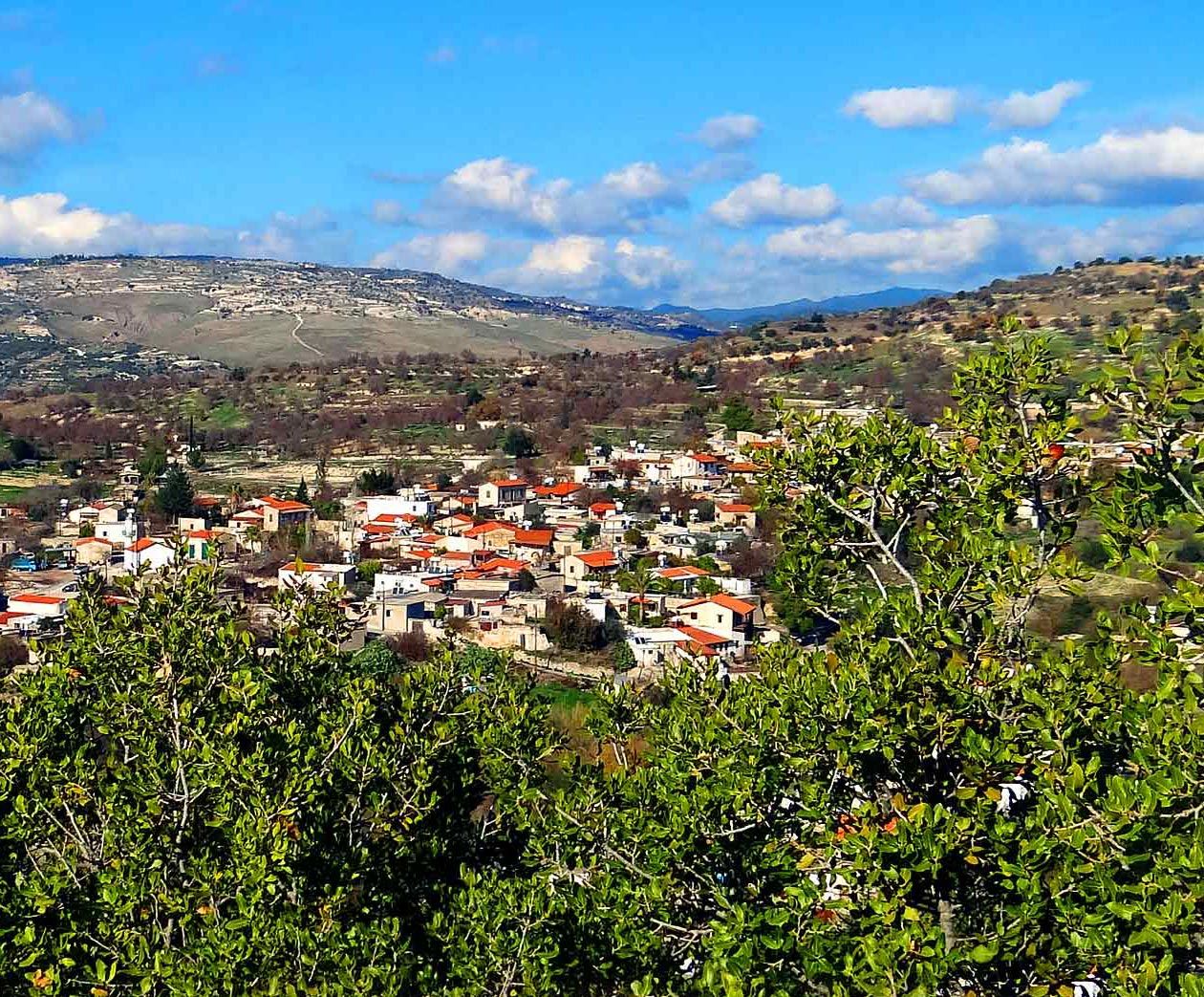
CHOULOU VILLAGE
CHOULOU VILLAGE
There are many wonderful sights and memorials for anyone visiting this beautiful historical village of Choulou, such as the many Chapels, the watermill, the lower fountain, Saint George Church, Saint Theodoros Church, the Church of Pantanassas, the mosque, the Ezousa River and the two stone arched bridges. Sights that will quench your thirst for a wonderful day out!
The name of the village comes from the founder and first settler of the area, who was from Syria. It is said that the name “Houlio” was the title that brought officials the Bektashi guild dervishes of Syria.
Another version of the origin is that the founder of the settlement is of a Syrian family: “Goul”, or the Syrian original family of the white genoas’, with the surname “Guli” Later, during the reign of King Peter the 1st Montolif and his family, whose origins were from the south of France.
This was referred to in the chronicles of Leontiou Machaira who was a great writer living in the period between 1360 -1450. He served the Frangous bosses who dwelled on the island during this time. The chronicles of Machaira bring extensive evidence of facts and persons who had direct relations with Choulou of Paphos.
At this time the owners of the land Choulou, John de Montolif and his wife Joanna d’Aleman lived in a palace; which was situated on the land next to the church of the nearby village Panagias of Pantanassa.
We note here that half of the church was built during this era, and was part of the palace. Joanna d’Aleman was young and beautiful when King Peter the 1st between the two young lovers and the feud that it caused between Joanna and King Peters wife Eleonora, a famous song came into being called “Arodafnousas” which is still popular to this day, in and around Choulou.
Some time later, the village became inhabited by Latinas and so became a dual community, Latin and Orthodox. The Orthodox people used the Church of Saint Theodoros, and the Latinos used the Church of Saint George. During the Ottoman invasion, the Turkish people forced the Latinos to leave the village or change their faith to Muslim. They also converted the church into a mosque which remains until today and is in excellent condition.
After the Ottoman period there is no official data found on the population of the village. Information begins to be written again, when the English begin to populate the Island. In the year of 1881 the population of the whole village was 434, in1891 it was 457, in 1901 it was 557, and in 1911 it was 605 habitants. In 1921 and 1931 population was 621 and by 1946 the number was now 820, of which, 703 were Greek Cypriots and 117 were Turkish Cypriots. Both nations cohabited harmoniously until 1964 which is the time when inter communal riots began between the people, and the Turkish Cypriots abandoned the village, after orders from Ankara to have all the TurkishCypriots gather together, from around the various different villages of Cyprus, in order to make them a bigger, stronger community.
This is why, after the census of 1973 the Greek Cypriot inhabitants of the village was around 600 but after 1982, was reduced to just 450.
From this time, the information gathered shows the dramatic population reduction due to urbanization. To this day, the inhabitants of the village are no more than 120 locals, together with a few British Expats who moved permanently to the village. (1359-1369) Choulou was owned by nobleman John de fell in love with her. Due to this relationship Geographical Position Choulou is situated 22 kilometres northeast of the town of Paphos. It is a mountainous area bordering the forests of Paphos. It boasts mild winters and cool summers without humidity, however, due to the mountainous area, there is the occasional snowfall. The altitude from the sea is just 400metres. It is also situated right beside the river of Ezousas.
In the village there are three establishments that are open to guests for overnight stays, one coffee shop, one restaurant and one snack bar, which provide daily refreshments to locals and passersby alike, all situated close together in and around the heart of the village.
Troodos Villages
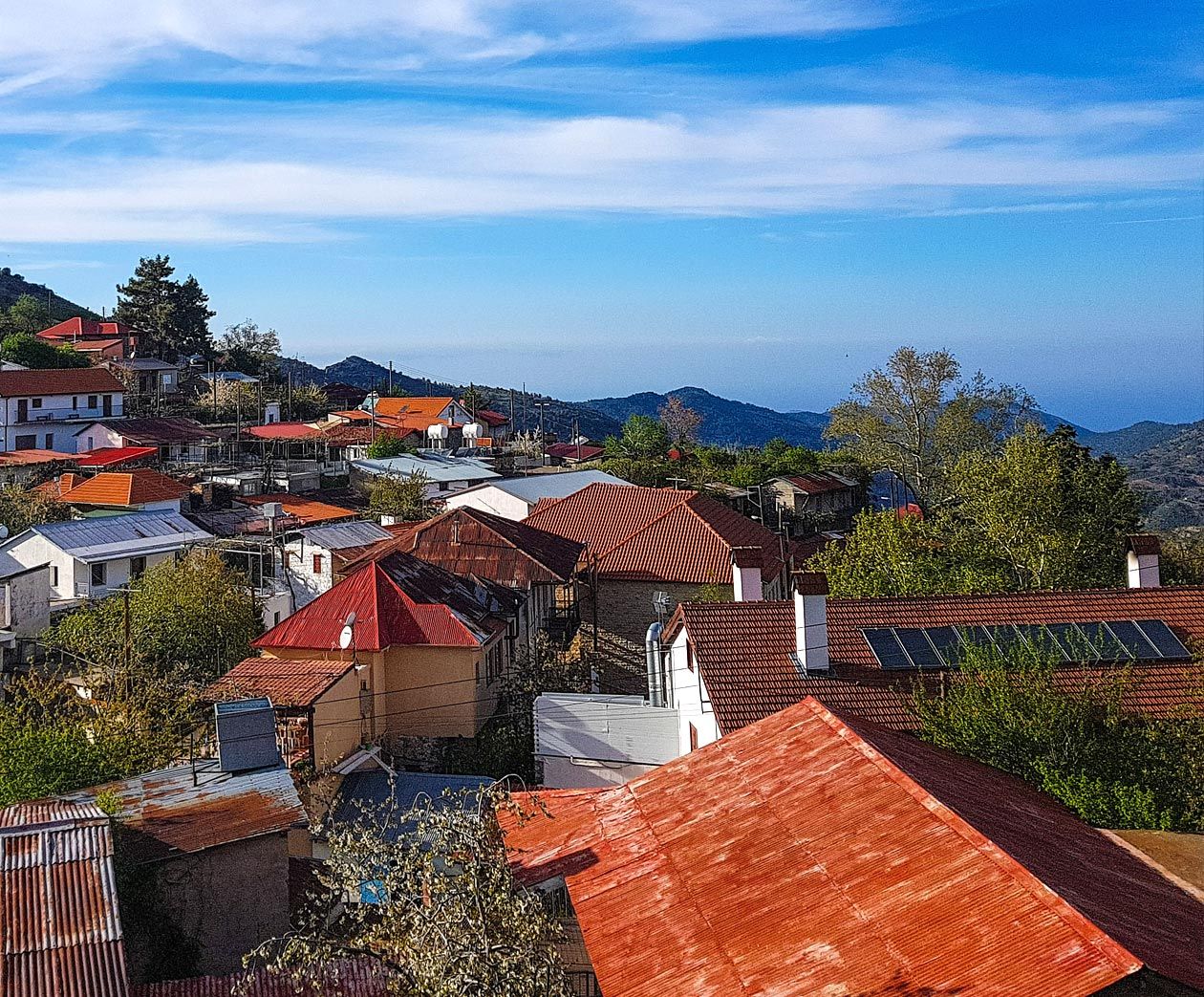
PEDOULAS VILLAGE
PEDOULAS VILLAGE
Located in the Troodos mountains, in the Marathasa Valley of the Lefkosia (Nicosia) district, the village of Pedoulas sits at an altitude of 1.100 metres. It can be reached from Lefkosia by following the E901, then the B9, followed by the E908, and finally the F960. Pedoulas sits amidst orchards and is particularly known for its cherries and the products made from the fruit.
The village is very significant in religious terms thanks to its important church of Archangelos Michael (1474), which ranks among the most impressive Byzantine churches in Cyprus with its amazing frescos. The church is part of the route of 10 Byzantine churches, which are included on the UNESCO World Heritage List. Close to the church is the Pedoulas Byzantine Museum, which was established in order to house and preserve icons and artefacts from churches in the region, with exhibits dating from the 12th century.
Its other interesting sites include the Folk Art Museum, which exhibits the villager’s daily way of life, customs and traditions of the past, and the natural spring, which is said to hold the key to longevity. Many visitors enjoy a refreshing drink of water from the spring when they pass through the village, or stay for a while at one of its quaint hotels.
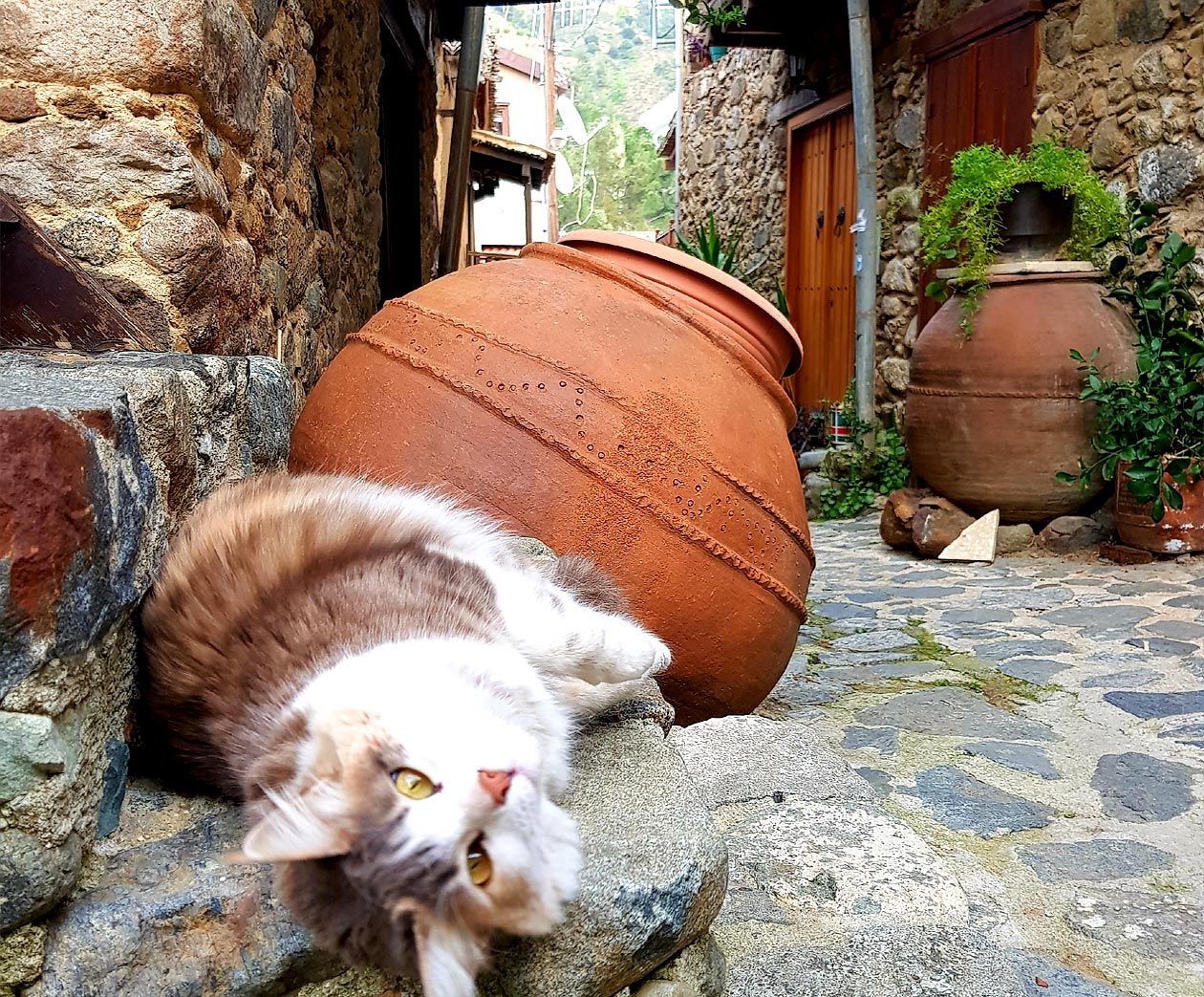
KAKOPETRIA VILLAGE
KAKOPETRIA VILLAGE
Located in the Troodos mountain range, in the Solea Valley of the Lefkosia (Nicosia) region, the village of Kakopetria can be reached from Lefkosia by following the route E901, then the B10, and finally the B9. The pretty village is a popular summer resort, thanks to its charming character and breathtaking scenery of pine forests that stretch across the Karkotis Valley. As such, it is ideal for agrotourism. The old quarter of the village - with its narrow, stone-paved alleys - has been declared a protected heritage site, and its two-storey houses with their wooden balconies have been restored.
The Church of the Saviour’s Configuration (Metamorfosis tou Sotiros), which is built in the centre of the old village is worth visiting, whilst the church of Agios Nikolaos tis Stegis (St. Nicholas of the Roof) is located 5 km from the village. It is considered one of the most interesting Byzantine churches on the island, thanks to its painted murals that date from the 11th to the 17th century.
The village also has several other interesting sights, including the Linos Musuem and Olive Mill museum. The watermill ‘Mylos tis Gonias’ used to grind barley and grain from 1754. It closed down after the Second World War, and was restored in 1980.
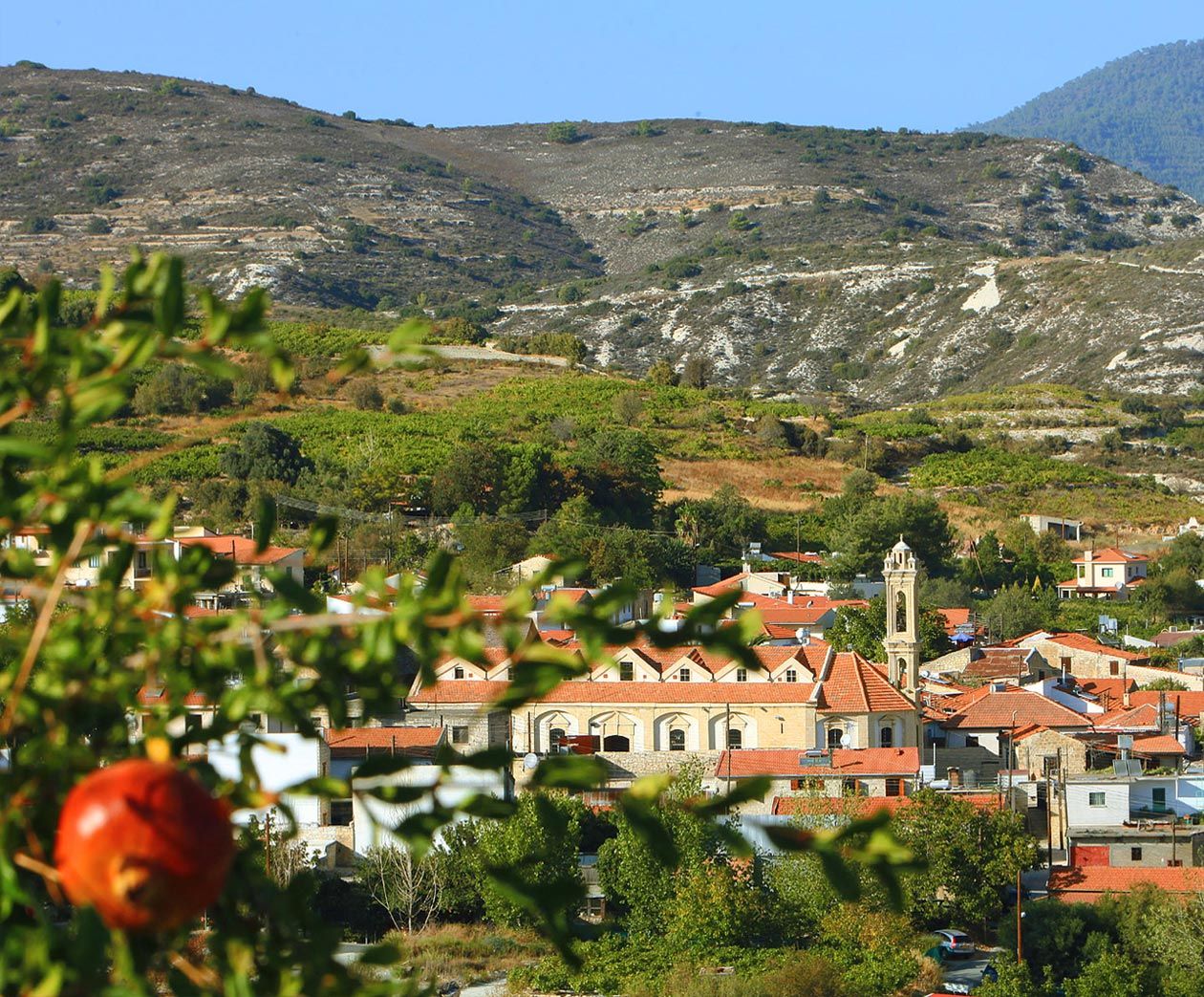
OMODOS VILLAGE
OMODOS VILLAGE
Located in the Lemesos (Limassol) district, the pretty, wine producing village of Omodos sits at an altitude of 800 metres on the Troodos mountain range, in the beautiful area of ‘Krassohoria’, just 42 km from Lemesos town. The village can be reached by following the E601 route, or by following the B8 route, then the E802 route and thereafter, the F825 route. Omodos is one of the most traditional and charming villages on the island.
The village has existed since the Frankish period and is marked as ‘Homodos’, and ‘Homoclos’ on old maps, with its name originating from the Greek word for street - ‘odos’.
Famous for its wine, Zivania spirit, handmade narrow-knit lacing and ‘arkatena’ bread, its quaint environs are perfect for agrotourism.
Despite its small size, Omodos has many interesting sights. Located within close proximity of one another are the cobbled square, old stone-built houses, local wineries, a Medieval wine press and the monastery of Timios Stavros (Holy Cross), with its old icons and impressive woodcarvings. There is also a museum dedicated to the National Liberation Struggle, as well as a centre for the preservation of narrow-knit lacing, and an Icon Museum.
Every September 14, the village holds one of the biggest religious fairs on the island, dedicated to the Holy Cross. The celebration lasts for three days, and vendors gather in the beautiful square in front of the monastery to sell their wares. The square is also the scene of many other events during the summer and Easter.
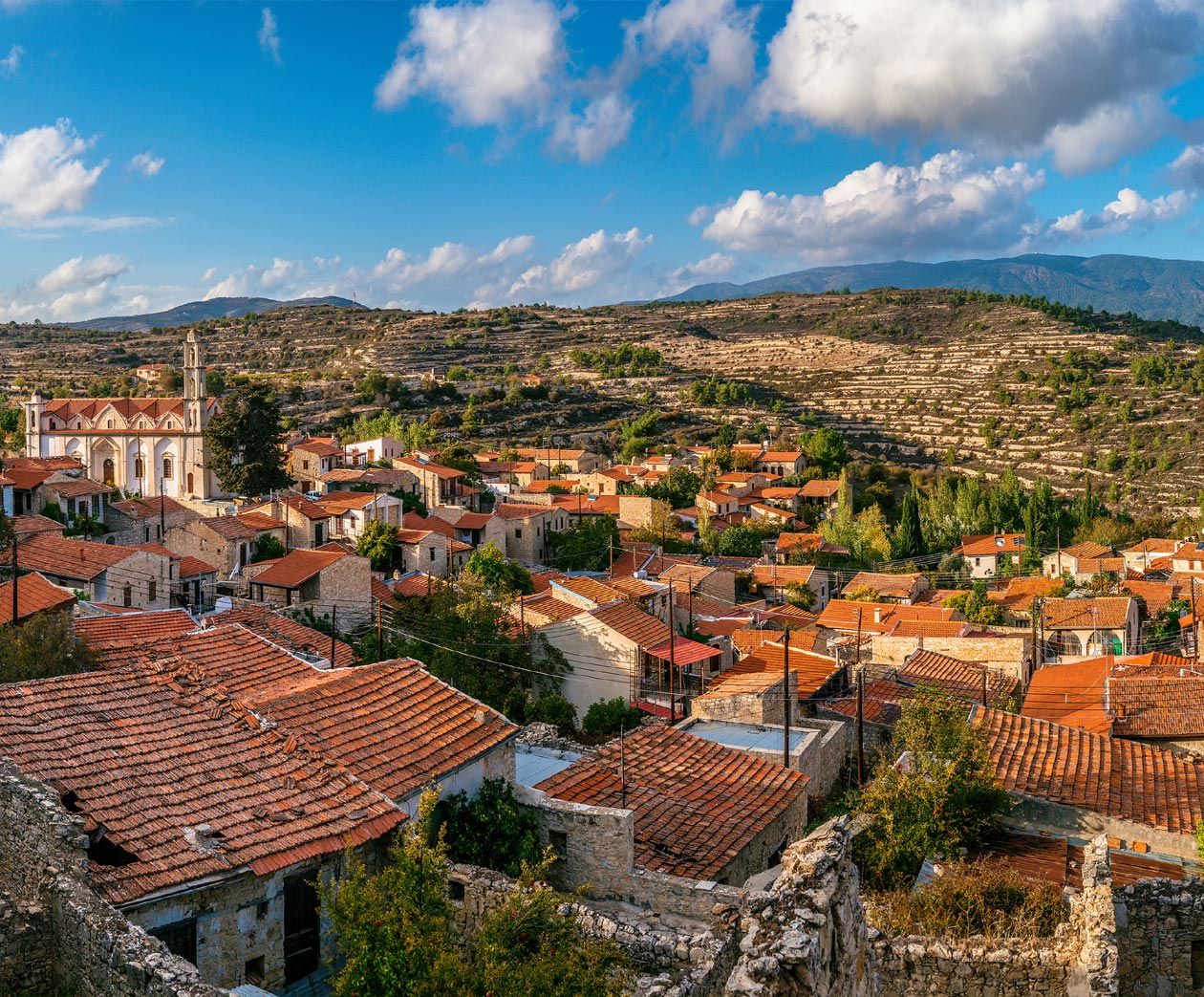
LOFOU VILLAGE
LOFOU VILLAGE
The village takes its name from its position on top of a hill (‘lofos’), and has retained its name since Byzantine times. It is renowned for its pretty, old architecture, and the many winding, cobbled streets.
The leafy environs of this picturesque and traditional village are home to grapevines and almond trees, offering agrotourism in tranquil and scenic surroundings.
Among its interesting sights are a small agricultural museum, the old school of Lofou, and the traditional faucet of Elitji, dating back to 1842. The faucet is where the villagers of Lofou used to collect water in the olden days, and was an important part of their daily life.
The village also has two religiously significant monuments; the 19th century village church dedicated to the Annunciation of Virgin Mary, and the nearby small chapel dedicated to Prophet Elias, whose icon is believed to have miraculous powers to stop the rains from causing damage to the grain crops.
At the end of September, the village celebrates its harvest with a Grape Fest, where visitors can watch the locals make traditional delicacies from grape juice, and sample them with their compliments. There is also a programme of folkloric entertainment, as well as wine tasting.
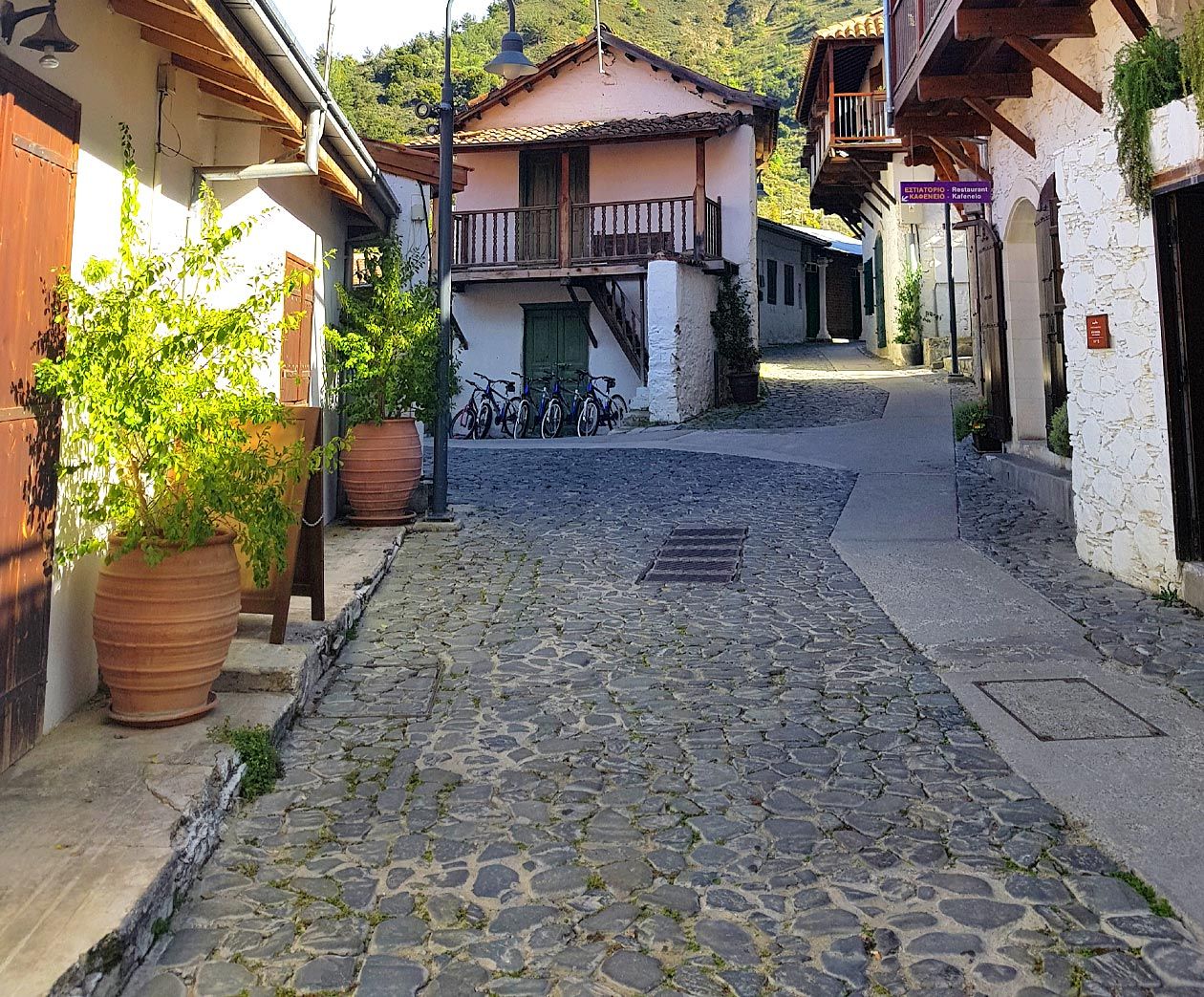
KALOPANAYIOTIS VILLAGE
KALOPANAYIOTIS VILLAGE
Located in the Troodos mountain range, in the Marathasa Valley area of the Lefkosia (Nicosia) district, the village of Kalopanagiotis is 70 km from Lefkosia and can be reached by following the E901 route, followed by the B9, the E908 and finally, the F958.
Kalopanagiotis is one of the most beautiful resorts on the island with its sulphur springs, traditional architecture and panoramic valley views, and is ideal for agrotourism in its peaceful surroundings.
The village’s name means ‘good Panayiotis’ in Greek, after the first inhabitant Panayiotis, who built his house near the Agios Ioannis Lampadistis monastery. The Monastery itself is on the UNESCO World Heritage Site list, and features three Byzantine churches with well-preserved frescos dating back from the 9th to the 15th century.
Interesting sights include the Venetian bridge and the Kykko watermill. The 16th century bridge was constructed from traditional stone, and until recently served as the only access between the village and the monastery. The watermillhas been declared a ‘heritage monument’ by the Cyprus Department of Antiquities, and is an imposing site, characteristic of architecture of the pre-industrial period.
Kalopanagiotis’ charm can also be felt in its other old chapels and churches, the quaint, cobbled streets, and footpaths that lead to beautiful nature trails.
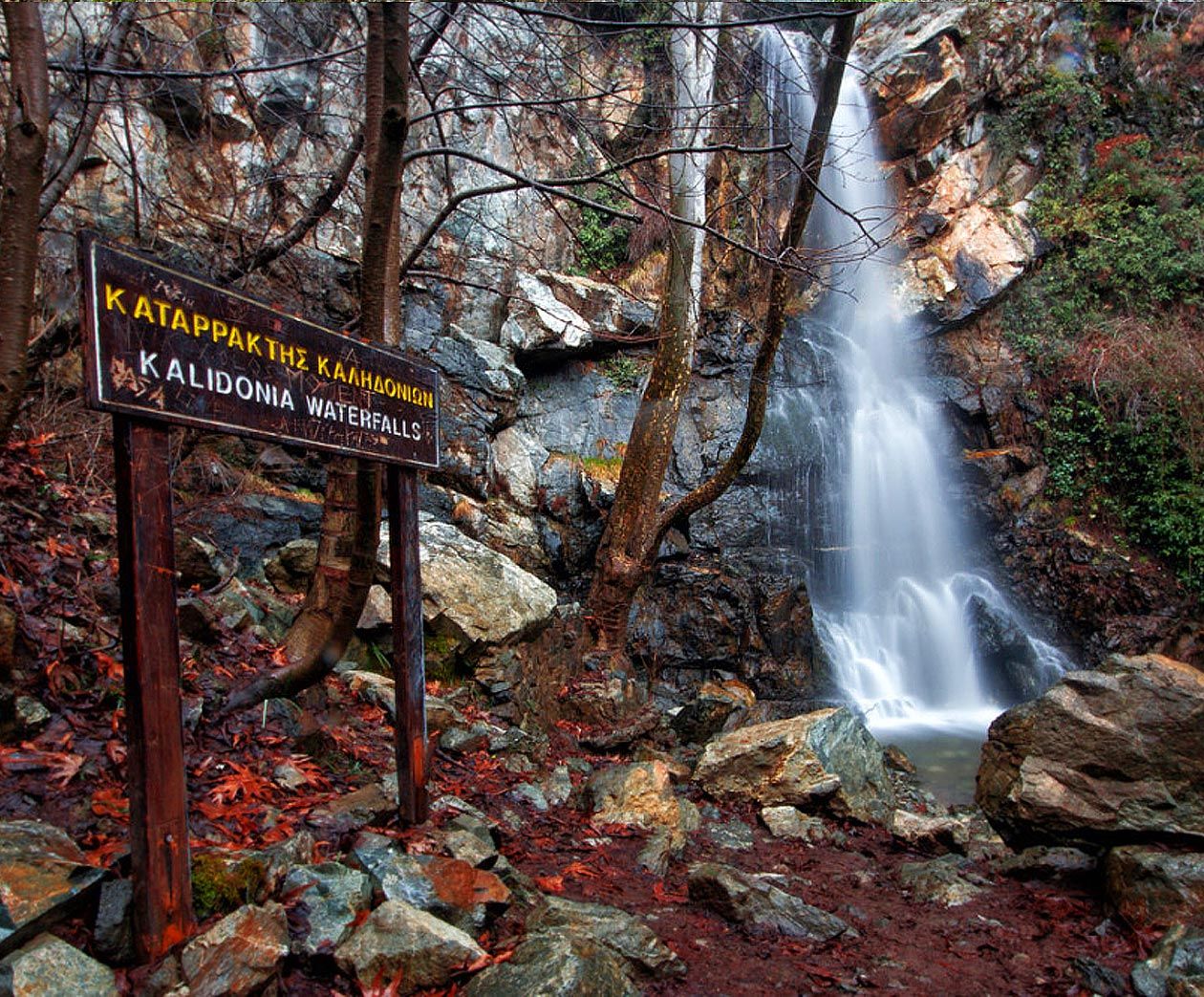
PLATRES VILLAGE
PLATRES VILLAGE
Located in the Troodos mountain range, in the Lemesos (Limassol) district, the village of Platres sits at an altitude of 1.100 metres. It can be reached from Lemesos by following the B8 route, and then the F825 for Kato Platres.
The picturesque village resembles an amphitheatre, with the lower part of the village having one altitude and the upper part having another, thus separating it into Pano (upper) and Kato (lower) Platres. It is a popular holiday destination and offers accommodation in quaint hotels.
There are various versions of where the village takes its name; from a ‘platria’ (saleswoman) who lived there; from the French word ‘platre-s’ - (‘white plaster’); from monks in white known as ‘Platrai’ during Frankish times, or from the word ‘platsa’.
Aside from the nature trails, Platres has one of the highest waterfalls in Cyprus - Caledonia - believed to be named by English or Scottish visitors to the area in 1878. The village is also filled with charming old buildings, and has a winery in Kato Platres.
Visitors will also enjoy its unique attractions, which include a chocolate workshop, an adventure rope park, and an exhibition at its Cultural Centre which incorporates old photos of the village, and of the Greek poet Giorgos Seferis.
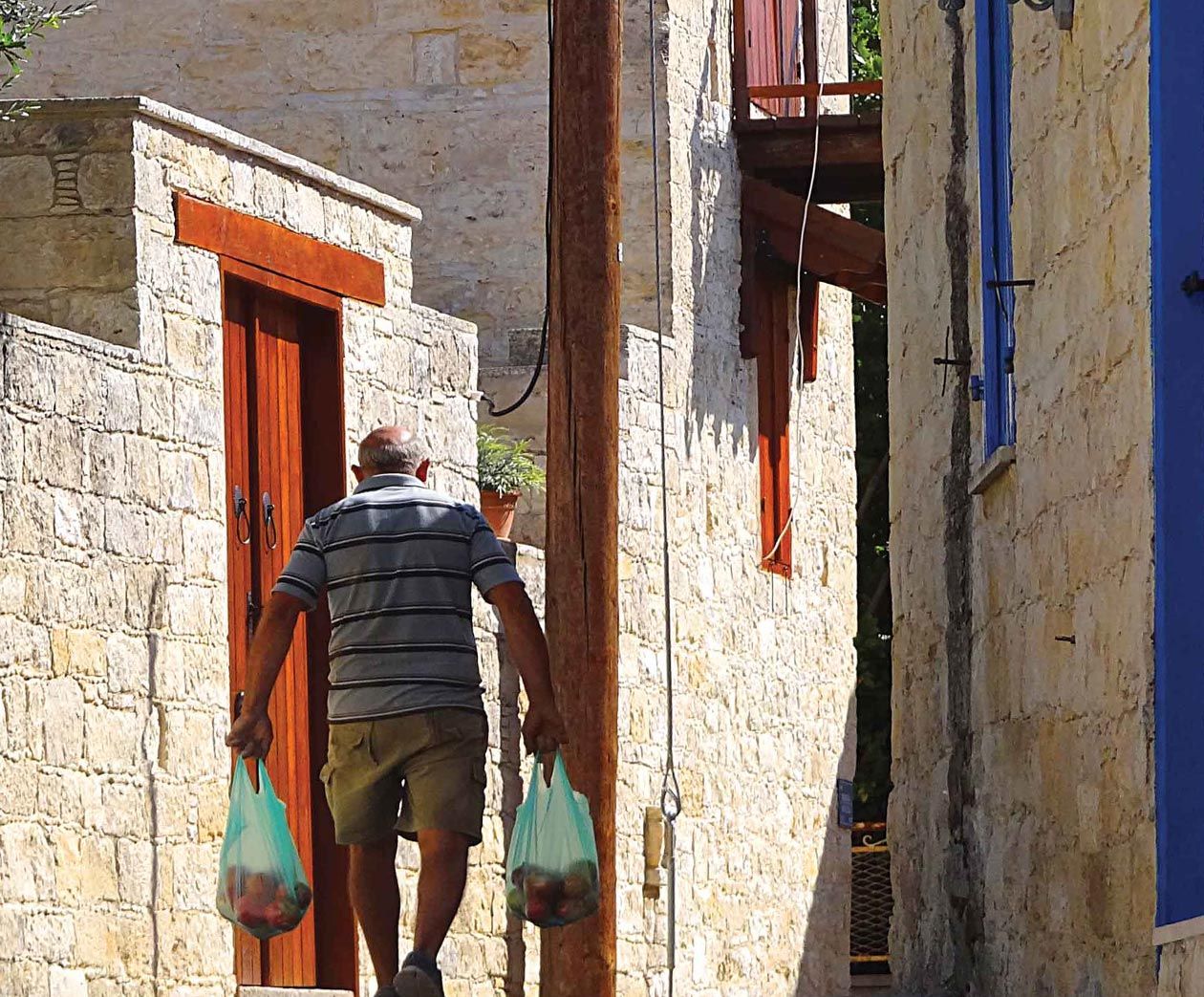
ARSOS VILLAGE
ARSOS VILLAGE
Located in the Lemesos (Limassol) district, the picturesque village of Arsos is built on the slopes of Laona mountain at an altitude of 850 metres, and just 42 km from Lemesos town. The village can be reached by following the A6 route and then the E601 route.
Arsos has practised the tradition of winemaking since ancient times, having developed into a large wine-producing village with a rich viticultural history.
Its name is believed to either come from the Holy Alsos (grove) of the Goddess Aphrodite, where the village is built, or its status as one of the four towns founded by Ptolemy Philadelphos in honour of Arsinoe.
Interesting sights include the Folk Art Museum, the ‘Six Fountains’ nature trail (that joins six medieval fountains along the river), its churches and a winery. Arsos is also an idyllic destination for agrotourism.
The village holds a Grape Feast annually at the end of September to celebrate its harvest, where visitors can watch how the locals make traditional delicacies from grape juice, and sample them with their compliments. There is also a programme of folkloric entertainment, as well as wine tasting. A second major event is held annually on November 14, with a religious fair in honour of Apostle Phillipos - protector of the village, with traditional stalls.
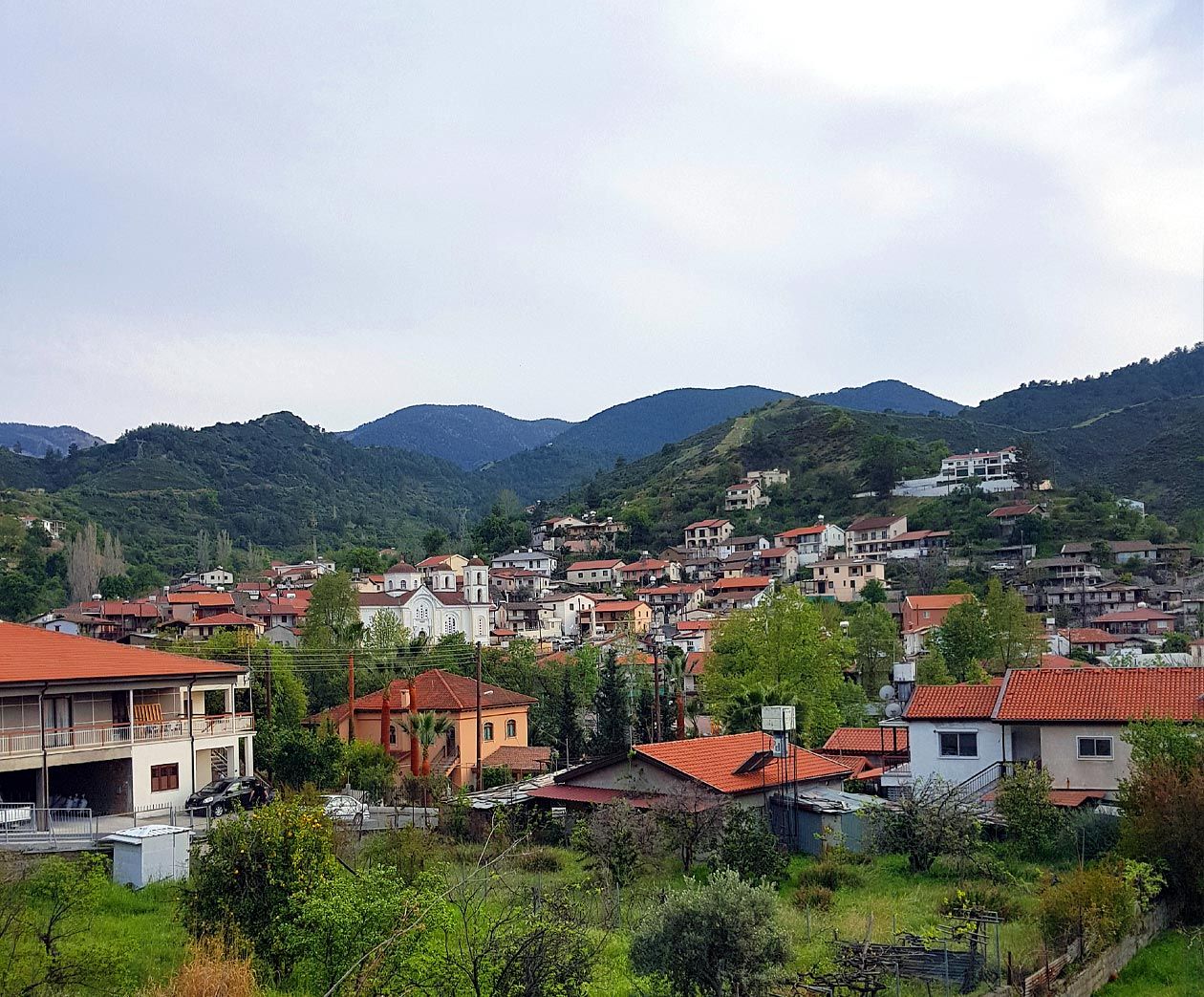
GALATA VILLAGE
GALATA VILLAGE
Galata is located 60 kilometres west of Nicosia in the beautiful valley of Solea. It has an altitude of 620 metres above sea level.
It is built in the two banks of the River Klarios that crosses through it and it is literally drowning in green. It is conjunct with the neighbouring community of Kakopetria. Both these twin hamlets receive thousands of tourists throughout the year.
Galata is famous for its tasty fruits that it produces in large quantities, especially apples of every variety, apricots, peaches, cherries, damsons, grapes, and others, as well as a variety of fresh vegetables.
If one wants to enjoy a few unforgettable summer moments in Galata, he / she must sit at the village's plaza. There, in the shadow of the age-old oak and the plane-trees with the Kargotis (Klarios) River, he / she will have unforgettable moments.
The houses of Galata -both the modern and the traditional ones -possess grace and beauty. One is particularly impressed by the wooden balconies and the wooden stairs of the old, traditional houses.
The tiled, inclined roofs, the local stone with which the houses' walls are made, the latches and bolts, the gateways with their wooden transoms, all these are unfeigned witnesses of contrived folkloric architecture, which is unfortunately dying away as time goes by.
Chiefly however, what is found here is an excellent cultural heritage. The six Byzantine churches with the pyramid-like roofs and their rectangular tiles present to the visitor an unparalleled Byzantine architecture, mainly from the 16 th century››. (Journeys in Cyprus, G and M Karouze).
The History and Tradition regarding Galata -- the village's name
In very old times, there where legend merges with history, in the "Esso-Galata venue west of today's village, some shepherds lived along with their flocks. The people who lived in the lower lands, the "katochorites" (lower-village inhabitants), went there in order to buy milk. The people would say amongst them "lets go over there to the ‹galataes› (plural, milkmen) and buy some milk". Out of "galataes", always according to tradition, came the name Galata.
Another tradition reports that the first settlers came from Galatia of Asia Minor and were named "Galates" (Byzantine era). So their small settlement was named Galata.
In his Chronicle (Annals), Leontios Machaeras reports that Galata belonged to the feud of the "Regas" (king) since 1196.
Galata is again mentioned by Leontios Machaeras in his Chronicle: ‹‹ … Learn…. These Maria said to me…. who took care of Mr. Erricos de Giblet in the village of Galata… ››.
Thus we come to the conclusion that during the Frank Domination era Galata belonged to the De Giblet family.
In Mediaeval maps Galata is found marked under the name Golata and Galata (Iacomo Franco 1570, Galata).
This is what the Russian traveller, Vasiliev Barksy, wrote in 1735 regarding Galata:
He first visited Galata and then the village's monastry of Podithou as he prescripes it.Then he returned back to the village were he spend the night.
‹‹ I went to the nearest village, named Galata, and spent the night close to a Christian along with my companions, which were priests. Let it be known that the villages of Solea have very few Muslim inhabitants, the majority being Greek Orthodox Christians, with many churches and priests. This village is the most beautiful of all. It has many fruit-bearing trees and running water and it is located next to the aforementioned river Klarios ››.
The Village of "Lampadou"
It is not known where exactly the village of "Lampadou" was built. However, the inhabitants of Galata as well as those of the surrounding villages -by tradition -starkly believe that this village or small settlement was located close to the country church of St. George the "Perachorites", east of Kakopetria and to the left of the tourist road to Troodos.
"Lampadou" or "Lampadis" or "Lampadistos" has been the birthplace of two of our Church's Saints, St Herakleidios and St. John the "Lampadistes" (the Illuminator).
The following reasons reinforce and confirm the view that Lampadou was located in the aforementioned area.
• According to St. John the Illuminator's "Akolouthia" (service) of 1667, he came from ‹‹ the hamlet of Lampadou of the Galaton district ››.
• In an unpublished manuscript (Φ13 β) it was mentioned that: ‹‹ He was a Cypriot -St. John the Illuminator -from the region of the Solea district, from the village Lampadou ››.
• The Russian traveller Barsky who in 1735 spent one night in Galata, during his tour ‹‹ in all the monasteries of Cyprus ›› mentions: ‹‹ John -a saintly man -the Illuminator from the village of Lampadis, where the Saint was born and which now has been abandoned as I have ascertained when I was in Solea ››.
• One of the "Aposticha" (types of verses) that refers to St. Herakleidios goes like this: « Τόπους αμειβόμενος οι του Σωτήρος Απόστολοι προς Σολέαν ιθύνονται και δόξαν κηρύττοντες Ιησού του Λόγου , άχρι της Λαμπάδου , ένθα και εύρον τον φαιδρόν θείον και πάνσοφον Ηρακλείδιον , δοχείον καθαρώτατον και μύστην υπάρχοντα Ελληνικής διαθέσεως , όν διδάξαντες έλεγον , σέβειν ένα Θεόν ημών », narrating how the Apostles, preaching the Word of God, came to Lampadou and taught St. Herakleidios about Christianity.
• In the service of St. John the Illuminator of 1774, h is mentioned as descending ‹‹ from the village Lampadistou of Solea››.
• Sofronios, the former Metropolitan Bishop of Leontopolis writes in his 1935 opus "Hagiology of the Orthodox Church": ‹‹ Saint John the Illuminator, from Cyprus (October 4 th ). In no hagiographer have I encountered a memoir of him… He is celebrated in Cyprus, descending from Lampadou (a village by the hamlet of Galata) and thus having this name ››.
• At a small distance outside Galata there is a bridge called "giofyrin t' Aerakleidkiou", that is bridge of St. Herakleidios.
• There is a venue quite near Galata named "Moutte tis Lampadou" (nose or peak of Lampadou).
• In the Byzantine churches of Galata and Kakopetria there are frescoes depicting St. Herakleidios and St. John the Illuminator.
• ‹‹ Again the mention of a settlement under the name Lampas in the "district of the Galates" indicates that the settlement must have been in the Solea region (where the large village of Galata is) ››. (History of the island of Cyprus, volume II, Andros Pavlides).
St. Herakleidios
From the Hagiography of St. Herakleidios -and also from other sources -we can conclude that he was an idolater (heathen) and a son of a certain Hierokleous or Hierokles, a heathen priest. It is known that the ancient people in Cyprus, like the ancient Greeks, believed in the twelve Gods of Olympus.
When the Apostles Paul and Varnavas came to Cyprus in 45 AD to preach the Nazarene's religion, they passed by Lampadou that was close to Galata. Here the Apostles met the then young Herakleidios along with his father who -at that moment -was offering a sacrifice to the Gods. Hierokles invited them to take part in the sacrifice. The Apostles refused. They only asked to be shown the wrote to Pafos.
Hierokles allowed his son, Herakleidios, to escort the Apostles and show them the way.
As they were walking, the Apostles taught to Herakleidios the true religion of Jesus Christ and its superiority, in comparison with the religion he believed in. Herakleidios was thrilled with the new religion, became a believer, and was baptised. The Apostles ordained him as the bishop of Tamassos.
St. John the "Lampadistes" (Illuminator / torch bearer)
St. John the Illuminator descended from Lampadou, as his surname reveals, just like St. Herakleidios. ‹‹ … from the renowned island of Cyprus, from the village of Lampadou in the district of Galata››. (Costas Myriantheas St John the Illuminator)
He lived during the 11 th century. His parents were the priest Kyriakos and his mother Anna.
He was nurtured with the essence of the faith and learned the holy scriptures from an early age. Because of his great love for God, he dedicated himself wholeheartedly to Him.
When he was 18 years old his parents were pressing him to be engaged, forgetting that their son was the fruit of their prayers and pleas.
After the engagement, John decided to break his engagement and dedicate himself to God. He announced to the parents of his fiancee his irreversible decision. In spite their bitterness and their feelings of being insulted, they pretended that they still had loving feelings for him. They invited him to dinner and poisoned him and as a result John was blinded. The scene of this lethal dinner with the poisonous fishes that they offered to him is depicted in a large portable icon, which is found in his monastery in Kalopanagiotis.
He was now blind. But he says "If they have taken from me the eyes of the body, the eyes of the soul exist, so that I will praise the name of God with greater zeal".
With the help of a servant who had the same name as he did, he leaves Lampadou and ascends to the monastery of his fellow-villager, St. Herakleidios.
He lived three years of angelic, ascetic life "teaching everyone that -if they want- they are able to live 'close' to Christ".
He was 22 years old when he delivered his "snow-white soul" to the Lord.